

THIS WEEK
CITY LIFE
04 Dilla’s Chicago NASCAR wasn’t the first to mount a road race here.
05 Shop Local A fashion collective strives to be responsible.
FOOD & DRINK ISSUE
06 Nature For ten years, serviceberry trees have lined the Bloomingdale Trail as part art installation, part environmental study.
08 Profile | Sula Chef Danny Espinoza
10 Farmers | Cardoza Growing food and community on Bray Grove Farm
13 Reader Bites | McFadden A map of our favorite bites thus far
14 Feature | Reid Whether fake or real, food props present challenges for theater artists.
18 Feature | Galil What west-side rapper K-Smoove brings to the table
THEATER
16 Plays of Note Billie Jean at Chicago Shakespeare, Frontieres Sans Frontieres at Theatre Y, Incognito with Tin Drum Theatre, and Pass Over at Fleetwood-Jourdain
FILM
17 Movies of Note Happy Gilmore 2 prioritizes star power over substance; Together is grotesque and tender.
17 The Moviegoer A birthday hello from Desperately Seeking Susan director Susan Seidelman and more
MUSIC
21 Shows of Note Previews of concerts by King Gizzard & the Lizard Wizard with the Chicago Philharmonic, Family Junket, and Patrick Shiroishi 23 Chicagoans of Note Worldrenownfailure, punk videographer
25 Gossip Wolf | Galil Jessica Risker returns a er seven years with a dreamy new album, Orchestra Resavoir reconvenes in Millennium Park, and more.
BACK
26 Savage Love Is my friend clueless or a selfinvolved asshole?

The Food & Drink Issue




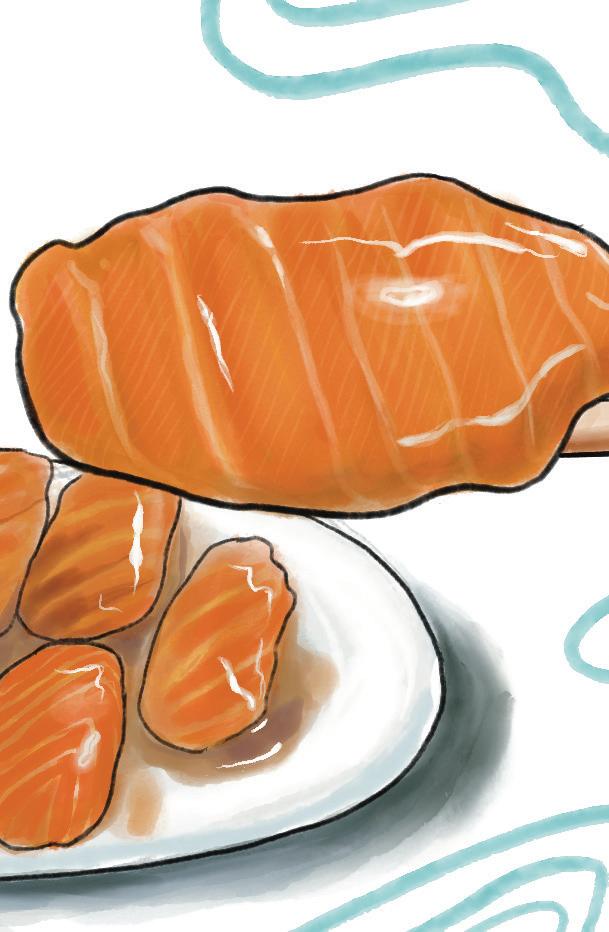

PUBLISHER AMBER NETTLES
CHIEF OF STAFF ELLEN KAULIG
EDITOR IN CHIEF SALEM COLLO-JULIN
ASSISTANT MANAGING EDITOR
SAVANNAH RAY HUGUELEY
PRODUCTION MANAGER AND STAFF
PHOTOGRAPHER KIRK WILLIAMSON
SENIOR GRAPHIC DESIGNER AMBER HUFF
GRAPHIC DESIGNER AND PHOTO RESEARCHER SHIRA
FRIEDMAN-PARKS
THEATER AND DANCE EDITOR KERRY REID
MUSIC EDITOR PHILIP MONTORO
CULTURE EDITOR: FILM, MEDIA, FOOD AND DRINK TARYN MCFADDEN
CULTURE EDITOR: ART, ARCHITECTURE, BOOKS KERRY CARDOZA
NEWS EDITOR SHAWN MULCAHY
PROJECTS EDITOR JAMIE LUDWIG
DIGITAL EDITOR TYRA NICOLE TRICHE
SENIOR WRITERS LEOR GALIL, DEANNA ISAACS, BEN JORAVSKY, MIKE SULA
FEATURES WRITER KATIE PROUT


SOCIAL JUSTICE REPORTER DEVYN-MARSHALL BROWN (DMB)
STAFF WRITER MICCO CAPORALE
MULTIMEDIA CONTENT PRODUCER SHAWNEE DAY
SOCIAL MEDIA ENGAGEMENT
ASSOCIATE CHARLI RENKEN
VICE PRESIDENT OF PEOPLE AND CULTURE ALIA GRAHAM



DEVELOPMENT MANAGER JOEY MANDEVILLE
DATA ASSOCIATE TATIANA PEREZ
MARKETING ASSOCIATE MAJA STACHNIK
MARKETING ASSOCIATE MICHAEL THOMPSON
SALES REPRESENTATIVE WILL ROGERS
SALES REPRESENTATIVE KELLY BRAUN
SALES REPRESENTATIVE VANESSA FLEMING
MEDIA SALES ASSOCIATE JILLIAN MUELLER
ADVERTISING
ADS@CHICAGOREADER.COM, 312-392-2970 CREATE A CLASSIFIED AD LISTING AT CLASSIFIEDS.CHICAGOREADER.COM
DISTRIBUTION CONCERNS
DISTRIBUTIONISSUES@CHICAGOREADER.COM
READER INSTITUTE FOR COMMUNITY JOURNALISM, INC.
CHAIRPERSON EILEEN RHODES
TREASURER TIMO MARTINEZ
SECRETARY TORRENCE GARDNER
DIRECTORS MONIQUE BRINKMAN-HILL, JULIETTE BUFORD, DANIEL DEVER, MATT DOUBLEDAY, JAKE MIKVA, ROBERT REITER, MARILYNN RUBIO, CHRISTINA CRAWFORD STEED
READER
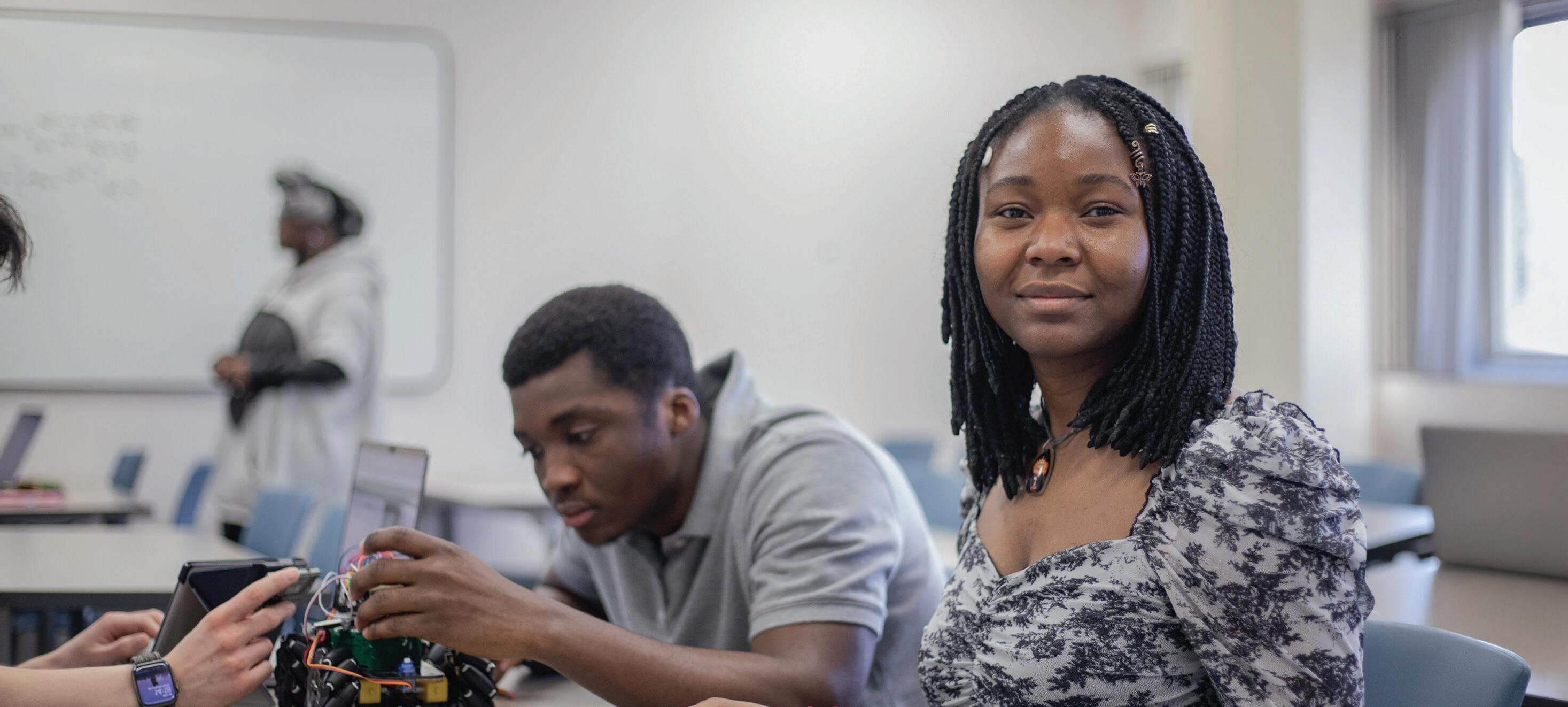






Dilla’s Chicago is a window into the hidden histories of Chicago-area people, buildings, neighborhoods, and more from Shermann “Dilla” Thomas. Thomas is a Chicago historian and content creator and the founder of Chicago Mahogany, LLC. He serves as the brand ambassador and chief of social media for the DuSable Black History Museum and Education Center.
NASCAR recently announced that their Chicago Street Race will be “paused” for 2026, with a potential return in 2027. Reactions from residents and media outlets were mixed. In full disclosure, I was paid by NASCAR in 2023 to do social engagement and content work, and in 2024, the organization paid my company, Chicago Mahogany, for sponsorship of several neighborhood tours we managed.
The event’s timing, as well as the street closures necessary to set up the racecourse (including shutting down portions of DuSable Lake Shore Drive during a holiday weekend), made the presence of the event a tough sell for many Chicagoans.
The weather has also complicated the event. The race has been hosted in Chicago for three years. While this year’s races came to a close just as rain showers rolled in, the 2023 and 2024 races faced lengthy start-time delays to accommodate heavy rains and wind.
Despite the challenges and controversies, we can still cite NASCAR’s Chicago Street Races as an official part of Chicago history, whether it returns to our city or not. Chicago will forever be known as the first city to host a NASCAR-sponsored race on a street course, and, as a historian, I think that’s pretty cool.
As a Chicago historian, I’m also obligated to inform you that the Loop 110 (the inaugural street race that NASCAR ran here, in 2023) was not the first car race held on Chicago’s streets. In fact, the first-ever auto race held in the U.S. took place right here in the city by the lake.
The Chicago Times-Herald Race was held on Thanksgiving Day, November 28, 1895. It was the brainchild of Times-Herald publisher H.H. Kohlsaat and was created not just to sell newspapers but also to promote the burgeoning auto industry. The first cars in the U.S. had been produced only two years earlier.
The winner of the race was promised $2,000, with $1,500 for the runner-up, $1,000 given to the third-place racer, and $500 for fourth. (In 2025 dollars, $2,000 in 1895 is approximately $76,539.)
The event was originally planned to run
DILLA’S CHICAGO
Car racin on Chicao’s srees before NASCAR
First-ever car race held in the U.S. took place right here
By SHERMANN “DILLA” THOMAS

through the streets of Chicago up to Milwaukee, turn around, and come back. But many roads north of Racine, Wisconsin, weren’t yet suitable for car travel. So a shorter course of around 54 miles was planned from the south side to Evanston and back, with the start and finish line located near the current location of the Gri n Museum of Science and Industry in Jackson Park.
Kohlsaat announced the race to the public on July 9, 1895, with the hope of attracting hundreds of entries. It was originally scheduled for earlier in the fall but had to be delayed because it took until October for the city to pass an ordinance allowing “horseless carriages” to operate on our streets.
The race finally happened on Thanksgiving Day. Eighty competitors had initially signed up, but only six vehicles actually arrived at the start line. This was partially due to the weather on race day: Overnight, a snowstorm had brought six inches to city streets, it was approximately 30 degrees Fahrenheit, and the wind was creating snowdrifts.
Let’s imagine these conditions for a moment. Chicago’s roads were not paved for cars at the
MORE FROM DILLA Find Shermann “Dilla” Thomas on Instagram or TikTok @ 6figga_dilla.
and horses. There was a lot of starting and stopping. And did I mention the weather?
Two of the racers drove vehicles powered by electric drivetrains, and the mechanisms didn’t do very well in the cold air. (Yes, we had electric vehicles back then. Chicago could have been the electric-vehicle capital of the country if not for World War II, but we can talk about that later.)
Of the six cars that started the race, only two finished. J. Frank Duryea of Massachusetts was the winner, driving a vehicle designed and built by his Duryea Motor Wagon Company.
The organization was the first firm in the U.S. to build gasoline-powered automobiles. The second-place finisher was Decatur businessman Oscar B. Mueller, who drove a vehicle built by German engineer Karl Benz (who later lent his name to the company we now know as Mercedes-Benz).
NASCAR have left the door open for a possible 2027 race here. But whether they return or not, it should be acknowledged that the Chicago Street Race helped NASCAR build awareness of and interest in the sport of car racing here in the midwest.
time, and we didn’t have tra c signals or any other modern road-safety measures. There were very few tall buildings in the city (which would have helped to stop the snowdrifts), and most cars didn’t even have roofs yet.
Cars and motorcycles were so new that many people had a hard time distinguishing between the two. We hadn’t yet come up with the word “motorcycle.” The word “automobile” was just starting to be used, and most people called them “horseless carriages.” The event sponsors would end up billing the event as a “motocycle” race.
The Chicago Times-Herald Race took the winner over ten hours to complete (of which nearly eight were running time). It didn’t take more than seven hours to get from Jackson Park to Evanston and back on horseback during those times. So why did it take so long in a car?
The average speed during the race was a blistering seven miles per hour. Additionally, tires on the race cars were made of wood in many instances, and they were constantly breaking and needing repair.
The race route was not totally shut down to the public, so competitors had to dodge people
The Chicago Times-Herald Race did the same in 1895 for the U.S. auto industry. After that race, car sales boomed. The race demonstrated that, even in bad weather, repairs could be made to automobiles and travel could continue. (Try getting a stubborn horse to move in the snow.)
NASCAR’s Chicago Street Races attracted many new fans, giving them a fantastic backdrop of Michigan Avenue and the Chicago skyline to look at behind world-class car racers. And NASCAR’s “all-in” approach to visiting Chicago didn’t hurt. They spent money supporting causes across the city. Their efforts definitely made a fan out of me.
Should NASCAR return to Chicago? I think so. Will it? That remains to be seen. What I do see clearly is that even when it comes to racing, everything dope about America comes from Chicago. v
m letters@chicagoreader.com
Dilla’s Chicago is sponsored by Clayco, a fullservice real estate development, master planning, architecture, engineering, and construction firm. Clayco specializes in the “art and science of building,” providing fast track, efficient solutions for industrial, commercial, institutional and residential-related building projects.


Duryea’s fi rst prize motor wagon COURTESY SCIENTIFIC AMERICAN
SHOP LOCAL
Woven memories
A Chicago fashion collective that considers every stitch—and each hand behind them
By ISA GIALLORENZO
Thoughtfulness, respect, inclusivity, and transparency—these are just a few of the values that define All We Remember, a “responsible clothing brand,” as cofounder Jacob Victorine describes it. So committed are they to their principles, they avoid using the buzzword “sustainable,” despite having every reason to claim it.
“Even though we work with organic materials and natural dyes, save the scraps from our production runs, try to limit waste during cutting, and manufacture locally in the U.S. (mainly in the midwest), we still ship items. The energy in our studio doesn’t come from renewable sources. So we acknowledge there’s some form of waste. We can’t visit every single factory we work with many times a year and there are other reasons we call ourselves responsible instead of sustainable,” Victorine says.
“We’re a tiny, self-funded brand with three main owners, two part-time employees, and an intern, so we don’t have the people power or financing to do every ethical thing we want.”
Having celebrated its fourth anniversary last year, All We Remember has charted an impressive trajectory since their first collection emerged in 2021. Run by Victorine, Rob Johnson, and Noah Zagor as a “responsibly made, gender-neutral clothing line with a focus on making garments and accessories in the United States using exclusively natural organic fibers and botanical dyes,” the brand has grown slowly but steadily, always valuing the materials they use and the people they work with.
The name All We Remember itself illustrates that ethos. As Victorine explains, “We wanted to honor all of the people whose expertise and labor goes into making our clothes. Oftentimes, a clothing brand will be known or named after the designer.” Victorine and

Zagor both also teach at Columbia College Chicago, and Zagor once owned Meyvn, a menswear boutique in Logan Square.
“And we wanted to point to the fact that many, many people contribute to our clothing being made—from the people weaving the fabrics, to Green Matters [Natural Dye Company] dying them, to our assistant designers Morgen Brenn and Shelby Olson, to the people making the buttons, to the people harvesting the cotton, to the teams at Sew Valley [in Cincinnati] and Digit Patterns [in Chicago] who help us with production, and so on and so on,” he says. “Often that sort of process and those people are obscured in the fashion industry.
And so we wanted to actually say, no—making clothing is collective,” Victorine continues.
“We also are very much rooted in traditional processes, which is an act of remembering— especially because many of these practices have been upheld by more traditional or Indigenous cultures for hundreds or thousands of years.”
The attention to detail is evident in every piece they make, including design features like hidden extra-large pockets and their “lichenized” drawstring, which allows waistbands to be easily—and stylishly—adjusted. Victorine says they draw on the concept of “simplexity,” meaning something that appears
CITY LIFE
simple at first glance but reveals deep complexity the more you engage with it. Their “Cove” styles, for example, are truly versatile and fit a wide range of bodies and genders. “People can often wear multiple sizes of our garments. I’ve seen husbands and wives sharing a jacket or a pair of pants,” Victorine says. All We Remember currently offers six sizes: 0 through 5, using a non-gendered, Japanese-inspired sizing scale. “0 is roughly an extra small, and 5 is roughly a double extra large,” Victorine notes.
Quality and durability are core tenets of the brand, which values high stitch counts and strong, flat-felled seams as much as natural fibers and botanical dyes. Their passion for garment longevity extends beyond design: They regularly host mending workshops, indigo dying sessions, and shibori classes at select shops across the country, including Rising Star Laundry in San Francisco and Heavy Market in Atlanta. Both shops also sell All We Remember’s designs.
“We have a couple of workshops coming up at a store called School of Thought in Brooklyn and another in partnership with our friends from [the] Literally Outside [brand] at [the boutique] Field Theory in Saint Louis. Those are really wonderful moments to connect and build community,” says Victorine.
Their recent collaboration with local artist Cody Hudson is another project the collective is especially proud of. The line includes T-shirts and bandanas screenprinted with natural indigo dye derived from indigofera tinctoria plants. The prints are bold and playful, with a lively spirit that evokes Marimekko’s iconic style. The pieces start at $105 for T-shirts and $65 for bandanas.
Operating out of a studio in the historic Kinzie Industrial Corridor—open to visitors by appointment—All We Remember currently sells their garments online. They’ll also be exhibiting their latest collection at Show and Tell, a trade show taking place August 4 and 5 at Morgan Manufacturing in the Fulton Market District. The event runs alongside the massive Chicago Collective menswear trade show at the Mart. Both shows are geared toward fashion industry buyers and require registration.
“We are interested in designing clothing that can be accessed when it’s first put on the body, but that can have meaning for someone over many, many years and wears,” Victorine says. v
T-shirts and bandanas from the x Cody Hudson Summer Solstice collection worn by Shelby Olson (le ) and Elliot Young JACOB VICTORINE
The Food & Drink Issue
& FAUNA
‘All flourishing is mutual’ on the 606
For ten years, serviceberry trees have lined the Bloomingdale Trail as part art installation, part environmental study.
By SHARON HOYER
Adecade ago, when landscape design
firm Michael Van Valkenburgh Associates was tasked with envisioning plant life on the 606 (known to its founders and neighborhood organizers as the Bloomingdale Trail), the group conceived of “rooms” of trees users would pass through while traversing the 2.7 miles of linear park. There’s the gauntlet of smoke bushes that form a rusty arch above Humboldt Boulevard in the summer, as well as the shady, rustling aspen grove just east of Drake Avenue. But there’s one exception to MVVA’s design concept—a single species of tree planted on the trail from end to end, conceived by artist Frances Whitehead as part art installation, part environmental study. It’s a shrubby, unassuming little tree prosaically named the serviceberry.
Serviceberries are native to Chicago and, unbeknownst to many, bear abundant yields of edible fruit for a few short weeks each spring. Locals in the know can be spotted sampling along the trail when dangling clusters of berries turn from red to purple and are at their sweetest. Those foragers are joined by many species of birds who feast at the higher branches.
The serviceberries on the 606 are monitored by about a dozen trained volunteers, citizen scientists who track when the trees leaf out, flower, bear fruit, change color, and drop their leaves. The serviceberry study is a longterm phenology project; that’s the study of the timing of biological events, and it’s critical to agriculture, forest management, and tourism industries (not to be confused with “phrenology,” the spurious study of bumps on human skulls). The serviceberry project is intended to measure the e ects of Lake Michigan and, over time, climate change, on the fruit-bearing trees. Volunteers are assigned a section of the trail and specific trees within that parcel. They upload observations to an app on a roughly weekly basis from April to October.
The data—along with that from myriad other phenological studies across the country—are publicly available on the USA National Phenology Network website and used by scientists to evaluate seasonal changes.
“The original scientific question was, would the trees at the west end of the trail bloom sooner?” said Bonnie Tawse, who has managed the program since 2022, when Friends of the Bloomingdale Trail took it over from the Trust for Public Land. “But we’ve found the trail is a series of microclimates.” For instance, trees planted near heat-retaining buildings leaf, flower, and fruit earlier than those planted in areas exposed to wind or shaded by taller trees. One trend in the data bears the unmistakable hallmarks of a warming planet: earlier leaf, flower, and fruiting times for three years running. That is, until this year, when a cool, slow spring with abundant rains returned the serviceberries—also known as juneberries—to their customary seasonal patterns. “We thought we might have to rename them mayberries,” Tawse joked.

“But that might seem like a reference to The Andy Gri th Show.”
Tawse and I met near the Spaulding access point of the trail back on June 11. Clusters of berries, most still green, hung from slender branches. She pointed out a ripe, purply berry for me to try. It was tart and sweeter than I expected, with a slightly nutty tinge imparted by its small seeds.
Five days later, I met volunteer Lisa Knaggs near Whitehead’s Environmental Sentinel emblem embedded in the pavement at the halfway point of the trail. I learned the cryptic compass is named after the serviceberry phenology project. The years 2015 and 2115, nestled between the compass lines, are an aspiration to one hundred years of data collection by citizen scientists.
Tawse described Knaggs as a “super phenology volunteer”; Knaggs described herself as a data nerd who created a separate spreadsheet so she could track changes in the data from year to year. She and the other phenology volunteers also serve as extra eyes on the trail, alerting the Chicago Park District not only to the health of trees, but maintenance issues as well.
By June 16, many more berries had ripened, and scores of robins swooped between trees. Knaggs said she spotted cedar waxwings feeding on the serviceberries last year. She noticed one lying beneath a serviceberry tree that she feared was dead, but she later learned the small birds can get drunk from gorging on berries and pass out.
Knaggs opened her phone and walked me through Nature’s Notebook, the app used by volunteers to upload their observations to the National Phenology Network database. She kindly gave me a paper copy of the map provided to volunteers to identify their trees. It’s a marked-up copy of the landscaper’s plans, which include a full inventory of all trees on the trail. The pages Knaggs gave me covered
one of her sections (she monitors several) near Rockwell, between the Sumac Tunnel and the Urban Savanna. Specific serviceberry trees are circled by hand. Monitored trees are numbered—some with handsome brass tags that have been an unfortunate target for souvenir-seeking visitors—and matched to a corresponding entry in the 606 project in Nature’s Notebook.
In honor of the tenth anniversary of the trail and the phenology project, Tawse and Friends of the Bloomingdale Trail released a serviceberry cookbook with recipes sourced from the community. Treats like lemon serviceberry olive oil cake, Tawse’s soda bread scones with serviceberries, and a “2.7 Mile Cocktail” from Weegee’s Lounge fill its small, spiral-bound pages. Knaggs’s contribution is a fruit smoothie fortified with spinach, almonds, and hemp. Charming illustrations by Kayce Bayer pepper the pages. Tawse, a writer by trade, is also the author of The Belt Cookie Table Cookbook Berries for Bloomingdale: The Serviceberry Cookbook is interspersed with short essays by Tawse defining phenology and the ethics of foraging.
Serviceberries along the 606 trail SHARON HOYER
FLORA
RBERRIES FOR BLOOMINGDALE: THE SERVICEBERRY COOKBOOK by Bonnie Tawse, Friends of the Bloomingdale Trail, spiral-bound paperback, 92 pp., $15, all proceeds go to Friends of the Bloomingdale Trail, bloomingdaletrail.org/our-first-cookbook

It’s mentioned in that brief primer, and is worth stating here, that foraging on Chicago Park District land is not legal. And yet, Tawse writes, “It seems a bit silly to imagine that visitors to the trail aren’t going to enjoy a few samples of the red and purple fruit when the trees are laden with them in early summer.”

Tawse credits mentors like ecologist (and former Reader contributor) Nance Klehm for her education in foraging. While there are a few specific guidelines, the rules are—as Tawse puts in the heading—common sense. “There is enough for you and the birds,” she told me as we sat in the shade of the aspen grove. “Leave enough for your neighbors.”
ATTENTION
The Food & Drink Issue
Considering each healthy, mature serviceberry tree bears more than ten thousand berries, and there are more than 450 of them on the trail alone, this is the easy and natural thing to do.
Serviceberries are having a bit of a moment beyond Chicago, thanks to a short book by famed botanist and author Robin Wall Kimmerer. In The Serviceberry: Abundance and Reciprocity in the Natural World , Kimmerer lauds the serviceberry as an exemplar of the ancient gift economies found in Indigenous cultures and, arguably, nature: systems of resource sharing distinguished by generosity, reciprocity, and abundance. Kimmerer posits that the scarcity and competition that define capitalist markets are socially constructed in the name of amassing wealth.
Despite their bounteous yields, serviceberries thwart commoditization. Their short fruiting period makes the trees impractical for commercial farming. By the time this story reaches print, the 2025 serviceberries will be long gone, and seasonal eaters will have turned to the plump tomatoes and syr-
upy stone fruits of summer. The ephemeral pleasure of eating produce at its peak is both a luxury and an imperative to share before the fleeting season ends. As Kimmerer writes, “Hoarding won’t save us. . . . All flourishing is mutual.”
Tasting the sweetness of the serviceberries on the trail and telling a curious jogger that, yes, they are edible, I experience a microcosm of the world Kimmerer imagines. Here is public land being enjoyed by neighbors of all ages and backgrounds, admission-free, bearing ample fruit if one just knows where to look. Citizens volunteer their time to observe the life on this land and contribute to a pool of knowledge openly and freely available, all in the interest of appreciating nature’s beauty and building a better world.
Friends of the Bloomingdale Trail will host a free tree walk conducted by volunteer Nandika Gervais on Saturday, August 16, from 6 to 7 PM. The walk begins at Damen Avenue and heads east to Ashland. v
m letters@chicagoreader.com
ATTENTION: PUBLIC COMMENT PERIOD FOR CHA’S AMENDED FY2026 HCV ADMINISTRATIVE PLAN SCHEDULED FOR JULY 28 - AUGUST 26, 2025
If you listed Lawndale Complex or the Lawndale Community Area on your Housing Choice Survey as a place you would like to permanently live, please read the information listed below.
The Chicago Housing Authority (CHA) is releasing its Amended FY2026 Admin Plan for public comment from July 28th through August 26th, 2025. The proposed Amendment is to allow CHA to support eligible families residing in units assisted by any special purpose including emergency housing voucher participants. The Amended Admin Plan and summary documents will be available for review July 28, on CHA’s website at www.thecha.org.
CHA welcomes questions and comments from residents, program participants and the general public, but participation in the public comment is not required and will not impact your housing options at CHA.
The Draft Tenant Selection Plan (TSP) and Lease for Ogden Commons, a mixed-income community is available for review. The Chicago Housing Authority (CHA) has worked with its development partner to develop a Draft TSP and Lease for use at the private development known as Ogden Commons (previous site of the Lawndale Complex). The units within this development will be used as replacement public housing units for Lawndale Complex and the Lawndale Community area. If you listed Lawndale Complex/Lawndale Community area on your Housing Choice Survey as a place you want to live or maintain a right to return to new CHA replacement housing per the Relocation Rights Contract (RRC), you can comment on the Draft TSP and Lease during the 30-day public comment period.
You can submit comments on the proposed plan by email, fax or mail:
Chicago Housing Authority 60 E. Van Buren St, 12th Floor Chicago, IL 60605
The 30-day public comment period will be held for CHA to receive written comments starting April 7 through May 7, 2021. The Tenant Selection Plans (TSP) will be available on CHA’s website beginning April 7, 2021.
Attn: Proposed FY2026 MTW Annual Plan Email: commentontheplan@thecha.org | Fax: 312-913-7837
Due to COVID-19, CHA has suspended all in person public meetings and instead, CHA will livestream one public comment hearing. The date and time of the public comment livestream hearing is as follows:
CHA will also host one livestream and one in-person public comment meeting:
Tue, April 20, 10:00am: https://youtu.be/QBGG47BHXMg
• Livestream: August 4, at 11:00 am Links to the livestreams will be available at www.thecha.org and a sign interpreter will be present. Comments can be submitted in the livestream chat and recordings of the livestream sessions will be available on CHA’s website following the meetings.



We ask that comments pertaining to the TSP & Lease be submitted electronically to commentontheplan@thecha.org at least 48-hours prior to the comment hearing. Comments will be read live during the time outlined above. Comments received after the hearing will be added to the comment grid.
• In-person: Wednesday, August 13, 2025, at 6:00 pm, FIC 4859 S Wabash Sign language and Spanish interpreters will be present, and comments can be submitted in person.
If you require translation services, please read the attached notice or check with your property manager for more details. Do not mail comments to CHA.
E-mail or Fax comments to: commentontheplan@thecha.org Fax 312. 913.7837
If you require additional translation services, check with your property manager for more details.
All comments must be received by August 26, 2025.
Ifyouhaveaquestionaboutthisnotice,pleasecalltheCHAat312.913-7300. Torequestareasonableaccommodation,pleasecall312.913.7062. TTY 866.331.3603
If you have a question about this notice, please call 312-913-7300. To request a reasonable accommodation, please call 312-913-7062. TTY 866-331-3603



Native to Chicago, serviceberries bear abundant yields of edible fruit each spring. MIKE SULA
The Food & Drink Issue
You know Santa Masa Tamaleria chef Danny Espinoza, but you don’t know about his day job
Innovative tamalero on the weekend, corporate recipe developer on the weekdays
By MIKE SULA
Adozen eight-ounce Ball jars of salsa sit on a gleaming stainless steel shelf in Danny Espinoza’s kitchen. There are samples of a tomato and chile de arbol–based salsa roja; a tomatillo- and jalapeno-based salsa verde; and a salsa casera, a hybrid of the two. They’ve been there since March and you can tell, particularly with the salsa verde, whose ordinarily bright tomatillo green has faded to a grayish, swampy pallor. Espinoza has no plan to splash these dulled sauces on the guajolota torta tamal at Santa Masa Tamaleria, the celebrated Dunning house of masa he owns with his wife, Jhoana Ruiz. Nor would they have applied it to the carne asada–topped johnnycake with esquites, huitlacoche fondue, and mushrooms three ways they recently served at Trecena, the fine dining Chicano pop-up they run every month.
No one is going to eat these dusty salsas. They’re part of a shelf-life study tracking color change over time that he’s conducting at his corporate day job for the multinational food ingredient supplier ofi, aka Olam Food Ingredients.
If you pay attention to Mexican food in Chicago, you know Danny Espinoza. He’s been a name restaurant chef for over a dozen years, beginning at the late, great Mexique, where he worked under Carlos Gaytan; and then in 2015, when he won Zagat’s “30 Under 30” culinary award, while working as the executive chef for the roving supper club start-up Dinner Lab. He also spent a year demoing recipes each Monday on Univision.
But you probably don’t know anything about his 9-to-5, to which he commutes about 50 minutes each day between Maywood and ofi’s 88,000-square-foot North American Con-

sumer Solutions Center on the second floor of the Marshall Field Building.
“I’m a quote, unquote expert when it comes to Mexican cuisine,” says Espinoza, whose ocial title is ofi’s corporate chef of North America. “My responsibility is the [company’s] Latino-Hispanic portfolio in regard to recipes and R&D. I bring in solutions for private label products or ingredients for other brands.”
He was hired almost five years ago as a kind of whisperer of pan-Latin cuisine for bigname corporate clients looking to create new products based on the latest trends. Say Big Snack Inc. wants a birria-flavored corn chip. Espinoza walks them through the history of the original dish: who developed it, and how, where, and why it developed.
And then he develops a recipe and hopes they don’t fuck it up.
“I found myself going to all these di erent big-box clients. I would introduce myself, or my title would say ‘Latin America Cuisine,’ and sometimes I’d get this pushback, ‘Well, we don’t do Latin American cuisine.’ That’s when I told my culinary director, ‘Yo, I’m a chef. I cook. Just call me chef and let’s get the work.’”
I met with Espinoza after lunch one Friday at the Solutions Center, which also serves as the corporation’s North American headquarters.
He had just led a group of colleagues on a taco tour of Pilsen that included the company’s private label team: the VP, a senior marketing manager, a project manager, and the director of sales.
The main mission was to taste different salsas.
They started at Los Comales to try the old-school taqueria’s birria ramen and its smoky roasted chile de arbol salsa. Next stop
was Carnitas Uruapan, which serves a mild jalapeño-tomato-tomatillo salsa with its chicharrón guisado. Next came 5 Rabanitos, which features at least seven salsas on its menu, including a three-chili tomatillo salsa. Then they finished at an outpost of the Taco Maya minichain, which features a salsa bar with five di erent options.
Espinoza made his test salsas about four months ago with a $1,649 gadget called a Thermomix TM6; it can perform the tasks of some 20 di erent appliances, and can be dialed in with such granularity that it can make a rustic salsa textured like one pounded in a stone molcajete, the ancient Mexican mortar and pestle he uses for special dishes at Trecena— and sometimes at ofi. When Espinoza and his colleagues—which include one other chef and usually six to ten food scientists, depending on the project—achieve their gold standard for these salsas, other departments get in on it, talking numbers, marketing, labor, and packaging, before going into full production. After six months to a year, those salsas will be bottled, shipped, and sold as a private label brand developed for a specific national retailer, which, like most of the clients mentioned in this story, can’t be named on the orders of ofi’s legal team.
“A Thermomix is often used as a development or R&D tool to simulate and compare processes that will later happen in large-scale plant kettles or industrial cookers,” he says, “especially in product formulation, recipe scaling, and thermal processing. Although as fancy as it is, I love using my molcajete when it comes time to R&D such salsas. It keeps me grounded and reminds me of where I come from, and where I’m going.”
Espinoza grew up near Grand and Pulaski in Humboldt Park and learned to cook from his mother and grandmother before he graduated from culinary school at Kendall College, where the administration wasn’t always straightforward about the economic realities of cooking for a living.
“I started with, say, 300 people, and I only graduated with 50 of them. And out of those, 14 years later, only maybe 15 of us are still cooking. I remember when I was 17, there was an orientation with the dean. He said that after graduating, with the value of a degree from Kendall, you’re gonna walk out of here and start making $85,000. I was like, ‘This motherfucker is lying.’ There’s no way we’re gonna graduate and make $80,000 off the bat, because I’m making $7.25 an hour on the weekend right now. Nobody spoke about food science and research and development.”
Despite that lack of experience, Espinoza was recruited to apply for the job at ofi among about a dozen other candidates—half of them also well-known Chicago chefs. He had just started Santa Masa Tamaleria as a pop-up a few months earlier, and had a baby on the way and no health insurance.

Chef Danny Espinoza KIRK WILLIAMSON
At first, he was skeptical, but the company’s former culinary director caught his ear when she asked him what he liked about tamales. “I told her, ‘I love making tamales because I don’t use pork lard, and I feel it opens an avenue for a lot of people, whether they have dietary restrictions, or allergens, or certain religious points of view.’”
“She said, ‘How would you like to feed the world?’” He thought that was kind of corny, but he was impressed by the company’s commitment to not using GMOs; creating upcycled foods from edible byproducts that would otherwise be wasted; and implementing sourcing, sustainability, and tracing protocols for their cocoa and co ee supply chains, which frequently come from notoriously exploitative industries.
Ofi operates some 15 of these Solutions Centers all over the world, from Amsterdam to London, Barcelona to Moscow, Guangzhou to Mumbai, where they develop products from their five main ingredient supply chains: spices, cocoa, co ee, dairy, and nuts.
Espinoza walked me through the Chicago facility’s three kitchens, named Sweet, Scratch, and Savory. The latter is Espinoza’s domain. Then we toured 13 different labs, first passing through the Customer Lab where a handful of nut butter-chocolate grinders called melangers were spinning mixtures of chocolate and a specific nut cream to create a spreadable approximation of a certain confection that went TikTok viral all over the world last year, but can’t be mentioned here.
He’d been laid o from Cantina Laredo at the beginning of the pandemic, where he oversaw some 45 cooks, 82-92 hours a week over three different shifts, with one day off each week. But corporate cooking and the more reasonable work–life balance that comes with it still seemed alienating. “I had no idea what the hell I was getting myself into. In my head, I felt like a poser, right? Imposter syndrome. Initially, it was, ‘What am I doing selling my soul to this corporate food science world when my world is behind the stove, working my ass o , mentoring, teaching, swinging for the fences, and hoping to God people see the stu we’re doing. That was my mindset. But what captivated me was that conversation.”
Next, we paid a visit to the Sweet Kitch-
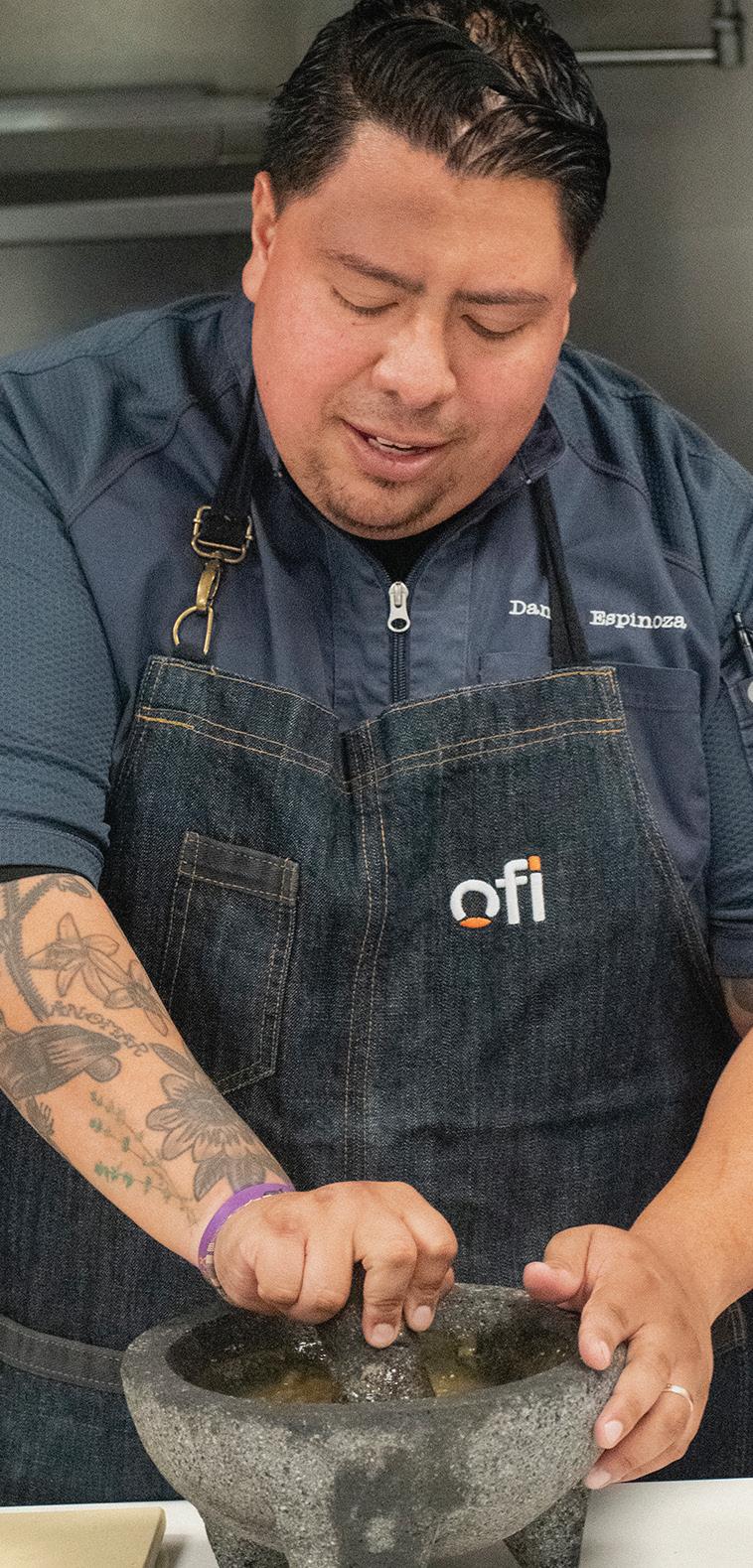
en, where Andrew Pingul, the former executive pastry chef at G.T. Prime and G.T. Fish & Oyster, was making little jellies out of cascara, the normally discarded husks of co ee cherries, that taste of tamarind.
Pingul was hired around the same time as Espinoza and was one of the reasons he accepted the job. “That guy’s a badass,” says Espinoza.
“When I started,” Pingul says, “the first couple of months, come four o’clock every day, I would get anxious, and I couldn’t figure it out. And then, oh! Shift change was usually at four o’clock in the restaurants, and that was when I was worried if my night shift was gonna come in, or if I was working a double or triple shift. Once it finally clicked, I was like, ‘I gotta let that go.’”
smoky chipotle pineapple, which hits the consumer-coveted sweet and spicy (“swicy”) convergence, are currently on the shelves as an anonymous megaretailer’s private label. Espinoza hasn’t kicked back outside of work despite the work-life balance his job offers. For the past two and a half years, he’s operated a wholesale-to-restaurants chorizo verde distributor (his own recipe), and on weekends, he’s at Santa Masa working on a forthcoming restaurant concept he’s not ready to go public with. A week after my tour, he served guajillo-braised chicken tamales with guajillo salsa to a sold-out crowd at the annual Copitas de Sol mezcal mixer at the National Museum of Mexican Art. As indefatigable as he sounds, he tries to take a power nap each day, and he journals to unwind, which has led to another project he’s working on: a comic book memoir with recipes.
“My experience of cooking is natural in the sense that it’s not linear. It’s not run through machines, but more by feel and memories, and driven by nostalgia.”

In the nearby Coffee Innovation Lab, food scientist Francis Sun was also working with cascara to create a refreshing, lightly ca einated upcycled beverage.
Then Espinoza took me into the spice lab, smelling of a Turkish bazaar, and stocked with some 70 spices and blends, all in di erent cuts, sizes, grinds, and flakes.
In the Advanced Analytical Chemistry lab, food scientist Leonard Fong showed me an $86,000 machine called an E-tongue that precisely quantifies tastes like bitterness, sweetness, sourness, and umami down to the molecular level in tested samples.
Finally, Espinoza took me to Nuts and Sauces, where he let me taste a series of upcycled sauces. The scorpion truffle and agave flavor, along with the sweet-andspicy mole and—my personal favorite—the al pastor–flavored
Around 4:30 PM that Friday, Espinoza was leaving work for Santa Masa for a five-course Trecena popup later that evening. But on the way out, he was stopped by his boss, VP of innovation John Martin, who, in his salsa-stained blue button-down shirt, had the dazed, blissed look of a man who had eaten too many tacos. “I’m so bloated,” he said. The food on that day’s taco crawl has a lot more in common with the food Espinoza and his wife cook at Santa Masa than it does with ofi’s endeavors: extraordinarily creative tamales, tortas, and tacos, unlike anything else in the city, but rooted in timeless methods that have survived the centuries. Espinoza has no need for E-tongues, high-performance liquid chromatographers, or the industrial-sized Rational iCombi Pro oven that looms over his Savory Kitchen at ofi.
“My experience of cooking is natural in the sense that it’s not linear,” he says. “It’s not run through machines, but more by feel and memories, and driven by nostalgia; all those good things that have been instilled by people that came before us. As much as that’s my favorite way of cooking, there’s a thing that I recognize that has made me a more disciplined chef: I still believe in measuring, keeping it consistent—but not treating it like a science experiment. I learned how to cook, not to follow recipes. Even at a corporate level, I still just try to be human about it. I’m not a machine. I’m not a robot. I think the strongest connection to both worlds is KISS: keep it simple, stupid.” v
m msula@chicagoreader.com
KIRK WILLIAMSON
The Food & Drink Issue
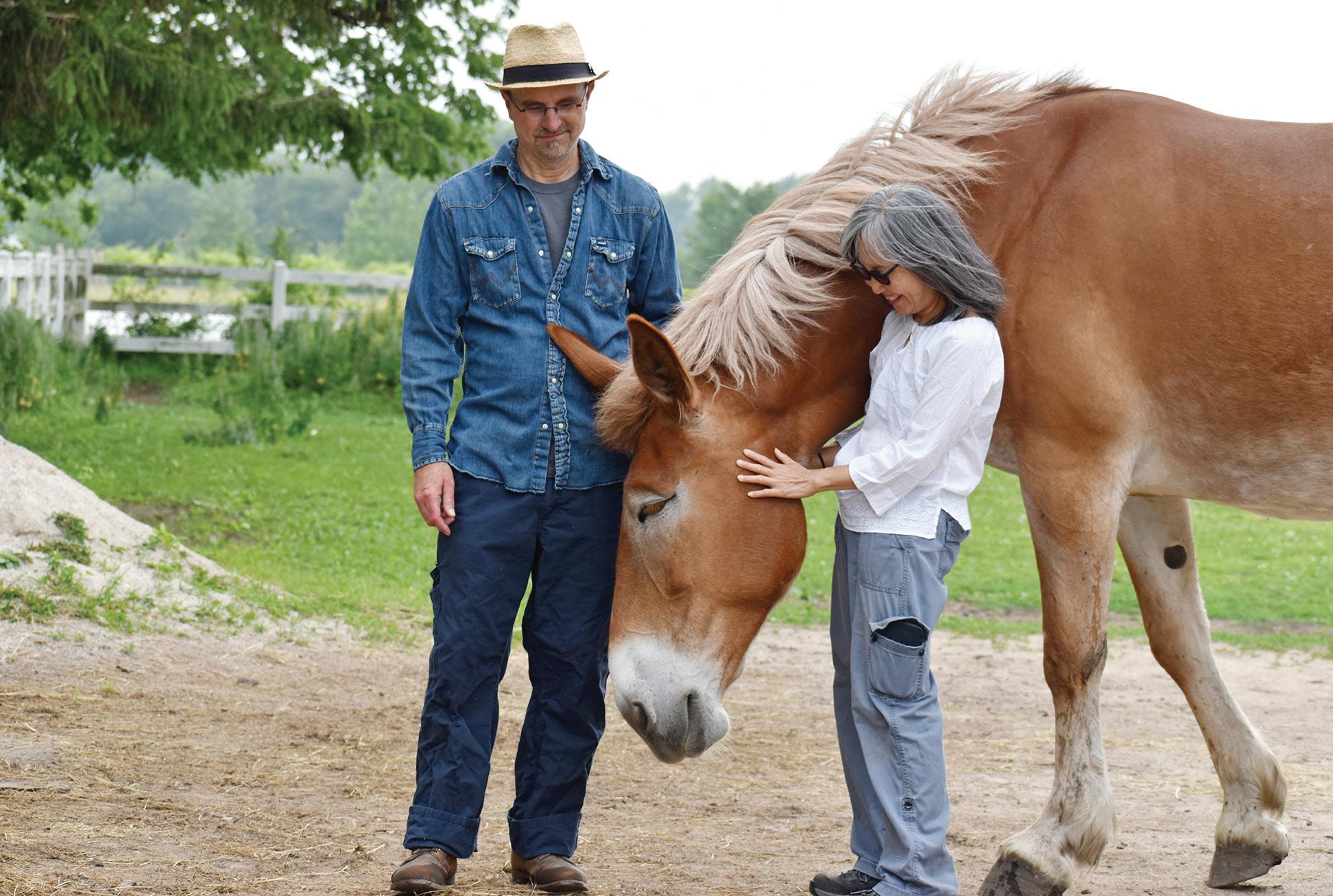
ART AND ENVIRONMENT
Cultivators
By KERRY CARDOZA
In a way, it all started with a horse named Cowboy.
When former Chicagoans Joanne Aono and Brian Leber decided to upend their urban lives to become farmers, they didn’t know where they’d end up or exactly what farming would look like for them. “Brian wanted to save a horse,” Aono said.
“I had read an article in the New York Times about the horse slaughter industry, which is the most egregious, horrific thing I’ve read. And after reading the article—we were actually at work—and I was like, ‘What if we bought a horse?’” Leber said.
The farm in Grundy County that they eventually bought, about an hour’s drive southwest of the city, was the second they’d considered. “What won us over—and it just sounds so crazy, because when we came, we didn’t look at the house first like most people would—we
looked at the land and the barn, and in the pasture was one single Appaloosa horse, named Cowboy,” Aona said.
Cowboy was elderly, almost 30 years old, depressed, and had cancer. The owners had tried to rehome him, but with no success, and told Aono and Leber that they planned to euthanize him. “That kind of pushed us over,” Aono said. “It’s like, ‘OK, we’re buying this place.’” “Cowboy needs me!” Leber joked.
The decision to save Cowboy, who lived for three more years, is indicative of Aono and Leber’s credo to work with nature rather than against it, to be good to all creatures, and to grow food for others. As the couple showed me around their farm, they pointed out a burn pile made of fallen branches and other yard waste. They hadn’t burnt it yet because a family of bunnies or skunks had made a home in it, and birds were nesting nearby. “Our whole raison
d’etre is giving a home to animals,” Leber said. And he meant it.
Before becoming farmers, Aono and Leber had varied careers. Aono, who grew up in Edgewater, is primarily an artist, often working on large-scale drawings or installations inspired by the environment or her research. A series of ephemeral outdoor installations, made partly out of seeds, is meant to take on a second life as birds and the elements scatter the materials. Spectral drawings on fabric, typically used as row covers, depict foods central to local Indigenous and immigrant communities. Aono is currently at work on a series about her Japanese American family’s relationship to agriculture and also serves as Riverside Arts Center’s exhibitions director. Through Cultivator, an alternative art exhibitions program, she’s blended her
work in the art community with life on the farm by inviting artists to show their work at public openings there. Cultivator, which is entering its eleventh year, focuses on underrepresented and emerging artists.
Leber largely worked on issues of human and environmental rights and development; he took his family’s jewelry business—Leber Jewelers—and turned it into a socially conscious one, using conflict-free diamonds and recycled gold.
They were living in a 1,000-square-foot condo in Lakeview when Leber broached the idea of moving to a farm. At the time, Aono was getting ready for several art exhibitions. “I told Brian, ‘I can’t even think about this now,’” she said. “‘Can we not talk about this until February?’”
In the meantime, she assigned him homework: a bulleted report on why he thought moving to a farm would be a good idea. And that’s what he did.
They closed on the land that would become Bray Grove Farm—named for the sound a mule
Annabelle, a Belgian dra mule weighing 1,900 pounds, with Brian Leber and Joanne Aono
KIRK WILLIAMSON
Brian Leber and Joanne Aono have found a saner, more sustainable way of living on Bray Grove Farm.

makes and the number of trees on the property— in 2014. It took a little while to get into the groove of farming the land. For one thing, the soil on the tenacre farm was depleted from decades of use in industrial agriculture.
Bringing the soil back to life and finding an equilibrium of what Leber and Aono could feasibly manage on their own was a process. “We made so many crazy mistakes,” Aono said. “The first year, we tried to farm this entire land. The two of us. We had, like, an acre of kale.”
“A lot of things formed on their own,” Leber said. “Like we learned, OK, it floods here. Let’s take that out of production.” That flooded area eventually turned to a grassy area all on its own, with clover and dandelion sprouting up—which are good for the soil and absorb the excess water.
The Food & Drink Issue
farmer Wendell Berry, a well-known champion of smallscale, sustainable farming (his book The Unsettling of
to bunnies and more. Though it’s a rural area with few other houses around, you couldn’t describe it as quiet; the birdsong alone is cacophonous.
“Allowing a little bit of overgrowth allows the birds to nest in the growth, and then they, in turn, help with the bug population,” Aono said. Their tomatoes are grown with posts so that birds can perch on them and feed on the hornworms. “There’s probably more life on our ten acres than there is in the surrounding 1,000 acres,” Leber said, surrounded as they are by huge swaths of industrial agriculture.

The
Now, a portion of the land is dedicated to food slated for Bray Grove’s CSA members— their primary source of income. A CSA, or community-supported agriculture, model means that community members pay for a share of the season’s o erings in advance and, in exchange, receive a regular box of whatever is in season. Bray Grove CSA members can buy a full or partial share and have the choice of picking up their weekly allotment on the farm or—for select areas—getting it delivered.
Over the course of the growing season, they plant about 90 kinds of produce, experimenting with varieties from different countries. Leber and Aono pride themselves on the farm’s low-intervention methods, where everything is GMO- and chemical-free. Their only input is what they compost on-site. They don’t have a full irrigation system or tractor, opting instead to cultivate their fields with two gorgeous, and gigantic, Belgian draft mules: Loretta and Annabelle. Anabelle, the younger of the two, is the friendliest—and the largest, clocking in at around 1,900 pounds.
America is a must-read), Leber was turned off by the idea of working with tractors. So he did his research and settled on draft mules, reading all he could on the subject.
“One December morning, as winter was approaching, I said, ‘OK, I gotta give this a whirl.’ So I took all the little bit of knowledge I had, put harnesses on the girls, and said, ‘You girls know what you’re doing. I don’t. Let’s give it a whirl.’ And with one word—‘clickclick’—we set o . . . . It was the coolest thing I had ever done.”
“What’s great is that things happen that we don’t plan,”

The remainder of the land features a small vineyard, stands of fruit and nut trees, pasture for the mules, and meadow—an uncultivated area meant for local wildlife. “We have low

“It’s just a tiny spot of land, but I think its impact is greater than its square footage.”
Aono said, pointing out a stand of trees growing naturally around the perimeter of their land. “That’s where industrial agriculture meets holistic agriculture, and nature is showing that nature can win,” Leber said. “What happened was they spray chemicals that predominantly kill leafy things like grasses and weeds. So it killed everything right up to our property line. We don’t kill anything. Well, in that tiny little vacuum, literally right along the lot line, woody plants like trees and stu could get a toehold.”
Taking inspiration from the writer and
intervention in pretty much everything we do,” Leber said. “It’s home to a lot of creatures, so it’s about as symbiotic as we can come growing.”
On both visits I’ve made to Bray Grove, it was teeming with life—from insects to birds
In addition to farming holistically, it’s been part of Bray Grove’s mission from the beginning to donate a portion of their best crop to local food pantries. They work primarily with We Care of Grundy County, typically donating at least 10 percent of their produce, though this year that amount has been reduced by extreme weather.
Though Leber and Aono have only been farming for about a decade, they’ve already seen an impact on what they can plant—and




farm grows about 90 varieties of crop on 10 acres of land. KIRK WILLIAMSON
The Food & Drink Issue
Let’s Play!

when—due to climate change. “The cliche spring vegetables don’t really grow anymore,” Leber said. “Because we go from winter where it’s too cool for anything to germinate, and wham, it’s in the 90s.”
Instead, they now plant traditional spring crops—things like peas, lettuce, and kohlrabi—in the fall, as the growing season frequently lasts until Thanksgiving, or some years until Christmas. “That was unheard of a couple decades ago,” the couple wrote over email. “If it keeps going at this rate, we’ll have great vegetables in February, but we don’t get to eat in July,” Leber said.
The more extreme weather has also meant long periods of drought followed by fiercer episodes of rain—a strain on farms that rely on hand watering. “There’s a point where it’s like, now is this sustainable? And the bigger picture is, maybe as a society, we need to look at, what are we eating?” Leber said. He suggests a move toward growing more annual crops, such as grapes, rather than perennials, or relying less on delicate, labor-intensive crops like lettuce.
Bray Grove is somewhat of an anomaly in the landscape of Illinois agriculture, and it looks it. The rich black soil of their farm is surrounded on all sides by the dry, nutrient-depleted brown of Big Ag. Out of more than 71,000 farms in the state in 2022, only 8.5 percent were nine acres or less. More than 80 percent of Illinois farmland is devoted to industrial agriculture, primarily corn and soybeans not intended for human consump-
tion. A 2018 report from MIT’s Union of Concerned Scientists ranked Illinois the 49th state in terms of sustainable farming practices and food health. Leber and Aono’s farming practices haven’t necessarily made them popular in their area—both report being pressured by neighbors to use pesticides or transition their land to corn and soybean production instead. But they’re not deterred.
“I feel a mission to be a bastion of sanity amid a sea of agricultural madness,” Leber said. “It’s just a tiny spot of land, but I think its impact is greater than its square footage. I think it makes people feel better. I mean, yes, we feed people, and part of our farm mission is providing sustenance to all creatures.”
But it’s also more than that. Visitors to the farm—folks stopping by for Cultivator events or picking up their CSA shares—remark on feeling better at Bray Grove. “Human beings are genetically predisposed to a saner way of living, and it’s just—capitalism has done its best to trash that. So every time there’s some rebellion against that, I think there’s progress, or at least hope.”
Despite all the challenges they face—the long days of manual labor, the inability to take a vacation, the harshness of neighbors—they don’t miss their former lives in the city.
“Sometimes we talk about our previous lives, living in Chicago and then living here, and like we never would have thought that this would have happened,” Aono said. “But we’re really grateful.”
Behind Bray Grove’s vineyard is an industrial farm that devotes vast areas to corn. KIRK WILLIAMSON
List of Restaurants:
1. Tostini 1622 W. Morse
2. The Common Cup 1501 W. Morse
3. Annapurna Simply Vegetarian 2600 W. Devon
4. Alice & Friends’ Vegan Kitchen 5812 N. Broadway
5. Sfera Sicilian Street Food 5759 N. Broadway
6. Mella Cafe 5418 N. Broadway


7. Minyoli 5420 N. Clark
8. Nobody’s Darling 1744 W. Balmoral
9. Middle East Bakery & Grocery 1512 W. Foster
10. Nhà Hàng Vietnam Restaurant 1032 W. Argyle
11. R&A Sourdough 1938 W. Lawrence
12. Antepli 4849 N. Kedzie
13. Somethin’ Sweet Donuts 4456 N. Kedzie
Roasted chicken and red pepper relish sandwich













35. Jackalope Coffee & Tea House 755 W. 32nd
36. Shinya Ramen House 3240 S. Halsted
21. The Smoothie Joint 948 W. Newport
22. Bonus Round Game Cafe 3230 N. Clark
23. Cafe Yaya 2431 N. Lincoln
24. The Violet Hour 1520 N. Damen
25. Baba’s Famous Steak & Lemonade 3958 W. Monroe
26. Kaiser Tiger 1415 W. Randolph
27. Elina’s 1202 W. Grand

14. Community Tavern 4038 N. Milwaukee
15. Santa Masa Tamaleria 7544 W. Addison
16. Loaf Lounge 2934 N. Milwaukee
17. Parachute HiFi 3500 N. Elston
18. Armand’s
28. Drip Collective 172 N. Racine
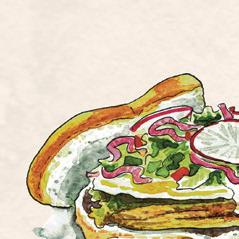
20.


29. Hanabusa Cafe 29 E. Madison
30. Swadesi Cafe 328 S. Jefferson
31. Novel Pizza Cafe 1759 W. 19th
32. 312 Fish Market 2105 S. Jefferson
33. Sushi Plus 2131 S. Archer
34. Punky’s Pizza & Pasta 2600 S. Wallace

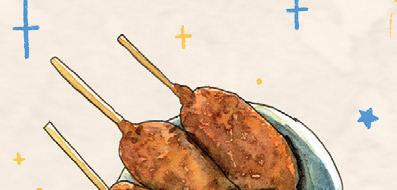
37. Cadinho Bakery & Cafe 3483 S. Archer
38. Antique Taco 1000 W. 35th St.














39. Ramova Grill and Taproom 3520 S. Halsted
40. Stockyard Coffeehouse 558 W. 37th St.
41. Binny’s Kenwood 1240 E. 47th St.
42. Daisy’s Po-Boy and Tavern 5215 S. Harper
43. Nata Various pop-ups on the southwest side and beyond
44. Kane County Cougars at Northwestern Medicine Field 34W002 Cherry, Geneva
45. Village Creamery 8000 Waukegan, Niles
46. Tenjin Restaurant 3956 W. Touhy, Lincolnwood
In May 2024, the Reader launched a column called Reader Bites. Resurrecting the premise of the bygone, long-running Reader series One Bite (or One Sip, for beverages), Reader Bites highlights favorite dishes, drinks, and atmospheres from across the Chicagoland food scene. Paired with a colorful and appetizing illustration by cori nakamura lin of onibaba studio, each column describes the sensory pleasures of a memorable culinary experience.
In the past year, Reader writers have celebrated seemingly simple smoothies, well-balanced cocktails, perfect pizzas, an assortment of magical sand-






47. DeSalvo’s Pizza 1945 Central, Evanston
48. The Cheese People Various pop-ups in Evanston and beyond
Food & Drink Issue
wich combinations, and a huge range of sweet treats. The picks vary in vibe and sophistication, from a humble slice of coffee shop pumpkin bread to a luxurious bite of raw Hokkaido scallop to an abominable ballpark hot dog topped with bacon, bacon jam, and vanilla icing with a Long John doughnut for a bun.
Explore all Reader Bites picks at chicagoreader.com/food/reader-bites, find their homes on the map, and keep an eye out for plenty more to come.
—TARYN MCFADDEN
v


Bombón
Hōjicha latte
Duck fat corn dogs
Tonkotsu ramen
Guajolota torta tamal
Gỏi vịt (duck salad)
Guava Linzer cookie
Bun Dinger
The Food & Drink Issue
FEATURE
Fake or real?
A props designer and a director talk about the challenges and payoffs of working with food and faux food onstage.
By KERRY REID
Just as a great piece of theater tells a story, so too does a great meal. Sometimes the combination of food and theater leads to indelible memories. Ask anyone who saw David Cromer’s landmark 2008 staging for the Hypocrites of Thornton Wilder’s Our Town what they remember best, and chances are they’ll go into rhapsodic reverie about the real bacon frying on a real antique stove in the final scene. The smell (and sound) wafting through the Chopin basement space added emotional heft to Emily Webb’s journey back from death to a memory of one morning in her life. Proustian pork, if you will.
Seeing characters preparing and eating food—one of the most prosaic yet also profound elements of human experience—creates a level of relatability for the audience. Everybody eats, after all. But making onstage food work with all the other challenges of stagecraft requires following careful procedures while taking creative risks, and thinking about the people for whom the meal is intended— just like in real life.
Writers recipes
Rae Watson is the properties master for Glencoe’s Writers Theatre. In the past two years, she’s created the props for two Writers shows with a heavy emphasis on food onstage: Katori Hall’s The Hot Wing King (staged by Lili-Anne Brown in summer 2024), and the just-closed production of Madhuri Shekar’s Dhaba on Devon Avenue (directed by Chay Yew).
Hall’s play (which won the 2021 Pulitzer Prize for drama) takes place in a home kitchen where a group of Black men prepare for a hot wings competition in Memphis. Trays of chicken wings at various stages of preparation appear throughout the play. So how did Watson pull that o ?
Watson notes that every production process begins with a list of the props required, including what are called “expendables”: props


that will be destroyed or eaten in the course of the show that need to be replaced each time. Meetings with the other designers and the director take place a month or two before rehearsals begin to figure out what is actually expendable. As Watson notes, even if a script calls for an actor to eat an apple, the director may have decided that they just pick it up and don’t actually eat it, so a fake apple can be used.
“For Hot Wing specifically, we were looking at the script and we already knew that there was a lot of raw chicken onstage,” says Watson. “We knew we didn’t wanna do that because that’s a bit of a safety hazard.” (Nobody wants a salmonella outbreak.)
Making it all come together was a complicated process of figuring out what needed to be real and what could be fake at various points in the story. “There’s no recipe that comes with the [Hot Wing] script. So you kind of have to look at what it says they’re doing in

the show, and then figure out what is the actual recipe for this. What are we gonna see them actually doing?” says Watson.
“And then from that, we can kind of figure out, ‘All right, so these are the things that we actually see them eat. Here, we see them cooking, we see them cutting up and prepping the chicken, but we don’t see that chicken immediately being cooked and then eaten. So that can be fake chicken.’” The production team worked in points where the fake chicken could be swapped out for the real chicken without the audience knowing the di erence.
Watson says that she did talk to props designers on earlier productions of the show. But those productions were all done in proscenium spaces, and Writers uses a three-quarter thrust configuration. The audience is much closer, with many patrons looking down on the playing area, which makes verisimilitude even more challenging.
She notes that earlier productions used
hard plastic wings, with seam lines indicating where the chicken was to be cut. “The one thing I learned from talking to them that didn’t work was they tried to have their chicken stuck together with magnets, but then the chicken would stick to the knife.” Watson notes that Brown also wanted to make sure that the chicken could be thrown around during comic altercations in the show. “So we knew we wanted it to move like chicken.” The solution was to create silicone molds for the wings, using di erent colors to show the layers between the outer skin and the inner flesh. Since some of the wings were coated with marinade onstage, they also had to be dishwasher-safe so they could be cleaned between shows. “We did make sure that some of the cooking onstage was real, so that you can hear the cooking happening, you can smell it,” says Watson.
Watson has also worked with real food onstage many times. For a 2019 Writers produc-
Chicken wings props in progress (L top and bottom); The Hot Wing King onstage at Writers Theatre in 2024 RAE WATSON, MICHAEL BROSILOW
The Food & Drink Issue

tion of Henrik Ibsen’s A Doll’s House, she notes that the director, Lavina Jadhwani, wanted a character to eat macarons onstage. But the actor was vegan. “The main ingredient in macarons is egg whites. So I ended up having to do a bunch of research. I learned how to make vegan macarons. I ended up making about 900 vegan macarons over the course of that show.”
Dhaba on Devon Avenue takes place entirely within the kitchen of a struggling family-run Indian restaurant. One of the challenges there is that the actors (principally Anish Jethmalani and Tina Muñoz Pandya, who played the father–daughter chef duo in the play) had to do food prep onstage (including working with a real restaurant stove) while also delivering lines. Watson notes that a professional chef came in to teach the actors proper knife technique. “We really wanted to make sure that [the actors] feel comfortable and confident, and that the audience sees them being confident.”
“I try and get them all of their food props as early as possible, so that they can work with it as much as possible,” says Watson. “The more they can work with it, the more comfortable they feel with it, and then the more comfortable they’re going to seem doing it onstage.
the seams in the floor?”
The latter concern (and the possibility of unpleasant food odors lingering in the floor) was why Whiteside made sure the food offered to patrons—a piece of kielbasa with an apricot glaze, a piece of gouda cheese, and cucumbers in brine—were in small bite-size portions to lessen the chance of spillage. The server (J.G. Smith) was informed just as a real waiter would be on the contents of the food so patrons with food allergies or preferences could decline.
Budget concerns also play a part in how real food is prepared onstage. In The Last Wide Open , there’s a section where Michael Mahler’s character, Mikolaj, eats bigos, or Polish hunter’s stew, onstage. “So we made bigos and we brought in crock-pots,” says Whiteside. “The very first time we heated it up, it smelled amazing. And then after that, we never could replicate the smell, and we didn’t have enough budget to make bigos for every single show. So we then decided, ‘Well, that smell’s not gonna work,’ so we used just a canned stew.”
Nicolas Bartleson] actually used zucchini bread with some food coloring in it.”
Coming up next at American Blues is the world premiere of Kristoffer Diaz’s Things With Friends (August 22–October 5, directed by Dexter Bullard), which takes place at an increasingly fraught dinner party. Steak and wine are served onstage. Of course, it’s not real wine, but Whiteside notes that they ask the actors what they prefer as a substitute, and then also work with the costumer to make sure that if it’s spilled, it won’t ruin the clothes. The steak that’s consumed will be precooked, and then finished onstage, “so you get that sizzle,” says Whiteside.
Both Watson and Whiteside note that food creates a special atmosphere for patrons, onstage and off, and that the act of eating has so many emotional resonances. (It’s no coincidence that some of the richest dramatic scenarios onstage play out at family dinners.)
Even though we might not have an actual stove in the rehearsal room while they’re rehearsing, we’ve got a whole set of hot burner plates that they can use.”
American Blues specials
Last summer, American Blues Theater (ABT) inaugurated its studio space in its North Lincoln venue with Audrey Cefaly’s The Last Wide Open, set in a Chicago Polish diner. ABT artistic director Gwendolyn Whiteside staged that show, in which the audience was seated at actual diner tables and given small bites of food during the performance. (Elyse Dolan did the set dressing and props for the show.)
Whiteside notes that the research process began with trips to Polish grocery stores and diners to make sure that the spices visible on the set would be appropriate. But she notes, “We looked at food and beverage safety. For example, if we have the actors eat these props, when do we throw them away? Sanitation and cleanliness is a big one because, for example, if someone is directed to spill something, it gets all over if you’re actually using a sticky substance in the beverage or the food, and that gets on the props. Also, does it seep through
Checking with actors’ dietary preferences (as Watson noted with the vegan actor in A Doll’s House ) is also important for Whiteside as a director and performer. She recalls working as an actor in a production of David Lindsay-Abaire’s Rabbit Hole at Indiana Repertory Theatre. At one point, her character eats cheesecake.
“I was young, sort of inexperienced in any sort of eating on stage. And I thought their care of me was so great. They asked if I had dietary restrictions. They asked if I cared about the sugar intake. They asked if I had issues with food just as a human being, not necessarily like a dietary thing, but more of a mental or emotional issue.” Though Whiteside has not had an eating disorder, she says that that is also something to be sensitive about when asking actors to eat onstage, as well as just asking them what they feel comfortable consuming night after night.
ABT’s annual live radio-play production of It’s a Wonderful Life has always included cookies (made without any nut products, notes Whiteside) and milk handed out to patrons. After coming back from the 2020 pandemic shutdown, the company had to stop doing that for safety reasons. “[The audiences] viewed that as part of the experience, part of sharing. ‘I’ll stop by, pick up a cookie, and talk to Mike Mahler and Dara Cameron after the show and ask them how their life has been in the past year,’ because we have people who repeatedly see the show,” says Whiteside. The immersive experience of The Last Wide Open and giving treats to the audience drew in a way on that
“We did make sure that some of the cooking onstage was real, so that you can hear the cooking happening, you can smell it.”
“A lot of times I think that we as artists or patrons watching a play are like, ‘Oh, that’s fun. I wonder if that tastes good.’ And a lot of times, it can taste really good. But for an example, when we did Misery [staged by ABT in October 2024], we had the actors eating meat loaf. Well, they didn’t want to eat the meat loaf, which was fine. They wanted a substitute. So [props designer
same sharing of food as part of community. But even if audience members themselves are not eating the food prepared during the show, Watson observes, “There is something special about cooking onstage. You go to see theater, you know that it’s not real. But when you see those little things where it’s like, ‘Oh, this actually is real, this has a sink with working water, and that is an actual stove,’ it just brings you into the story a little bit more.” v
THEATER
OPENING
RLove match
Billie Jean is a paean to a tennis icon.
For those of us old enough to remember 1973’s “Battle of the Sexes” between Billie Jean King and Bobby Riggs, Lauren M. Gunderson’s Billie Jean, now in a world premiere at Chicago Shakespeare under Marc Bruni’s direction, provides plenty of nostalgic “I Am Woman” second-wave feminist vibes. And for fans of tennis in general, Gunderson’s play provides a snapshot of a time when King and other women were laying the groundwork for the superstars to follow (as a montage of women like the Williams sisters and Naomi Osaka at the end of the play makes abundantly clear).
From plucky preteen in Long Beach, California, seeking her first tennis lessons from a gruff coach to rising sports star to feminist icon—and finally, lesbian heroine—Gunderson’s Billie Jean (played with winning aplomb by Julia Antonelli as young Billie Jean and then by Chilina Kennedy in the adult version) serves up toughness on the court, even when she’s only earning what amounts to gi cards for winning Wimbledon. Her male colleagues make the real money, and the fight for equality for women players forms a big part of the story here, as Kennedy’s King coaxes other players to join the Women’s Tennis Association, winning early support from her staunch doubles partner, Rosie Casals (Elena Hurst).
But even as her public profile grows, her private life presents a public relations liability. We see a Billie Jean off the court who is worried that rumors about her true sexual orientation will upend her career and the larger cause of supporting women in pro sports. Not even the presence of loving husband Larry King (Dan Amboyer) can stop the rumor mill; when a former girlfriend, Marilyn Barnett, sues her for palimony, Billie Jean at first denies the allegations, but finally realizes that the only way to win this match is with full honesty. In 1981, she became the first female professional athlete to come out.
Much of Gunderson’s script plays like a dutiful conscious-upli paean to its subject matter. (Among other darker details elided from the story: Barnett had been le paraplegic from an allegedly self-inflicted fall at the beach house the two women shared.) Like a well-paced tennis match, the dramatic situations are served up and volleyed for a few scenes until being resolved. (The audience opening night, which included coproducer Lily Tomlin, greeted each King victory with applause.)
ing to care about women in sports in order to enact their hateful agenda. The choral recitations of King’s mantra—“pressure is a privilege”—capture the steely intensity of Billie Jean, the public figure. But Kennedy’s recurring explanation of how “love” in tennis means starting from zero and building from that base shows us welcome glimpses of the vulnerable woman behind the icon. —KERRY REID BILLIE JEAN Through 8/10: Tue 7:30 PM, Wed 1 and 7:30 PM, Thu–Fri 7:30 PM , Sat 2:30 and 7:30 PM, Sun 2:30 PM; audio description Sun 8/3, open captions Wed 8/6 1 and 7:30 PM, ASL interpretation Fri 8/8; Chicago Shakespeare Theater, 800 E. Grand, 312-595-5600, chicagoshakes. com, $73-$134
RCity of lost children
Frontieres Sans Frontieres is a brutal satire of imperialism.
Three children play in a garbage dump, which is also apparently their home. The leader, Win (Tania Gillian Ramirez), tries to teach the other two, Pan (Carrington Thornton) and Noon (Roesha “Ro” Townsel), English, though her own grasp of the language is tenuous. Pan resists learning how to say “I like apples,” because they really prefer mangoes. But when you’re a poor child in what has been variously referred to (by people in superpower nations, primarily) as the “third world” or “developing nations,” your preferences are negligible.
Organization (Nadia Pillay), who seems more interested in reaching a vague “quota” in serving the underserved and moving up in the organization than really connecting with the kids. (This one landed a little differently, given the gutting of lifesaving services from USAID by the Trump administration.) There’s a pair of clowns (Pillay and Jo JB Schaffer) who think art will fix everything. And there’s a menacing militia member (Collins) who represents one of the darkest realities for the kids.
There’s nothing subtle here, and at points Howze’s play reminded me of Suzan-Lori Parks’s 1999 play, In the Blood, in which a poor mother and her five children are similarly visited by various figures representing institutional responses to poverty. But what makes Howze’s play work despite some heavy-handed interludes is that the focus resolutely remains on the children. We see them trying to make sense of what is unfolding around them, while still being kids who want to play and explore. We see them actually forming a community, even if it’s one the outside forces cannot see or understand, much less improve. Waters’s staging in Theatre Y’s concrete loading-dock venue (they also designed the effective set, in which a wading pool becomes a bed and an old forkli becomes a tea shop) balances the playfulness of the kids with the menace and mindlessness of the adults, as does the nimble ensemble. It reminds us that the savagery of war and imperialism always lands hardest and first on the youngest among us. —KERRY REID FRONTIERES SANS FRONTIERES Through 8/24: Thu 7 PM, Sat 3 and 7 PM, Sun 3 PM; Theatre Y, 3611 W. Cermak, theatre-y.com, free, but reservations suggested.
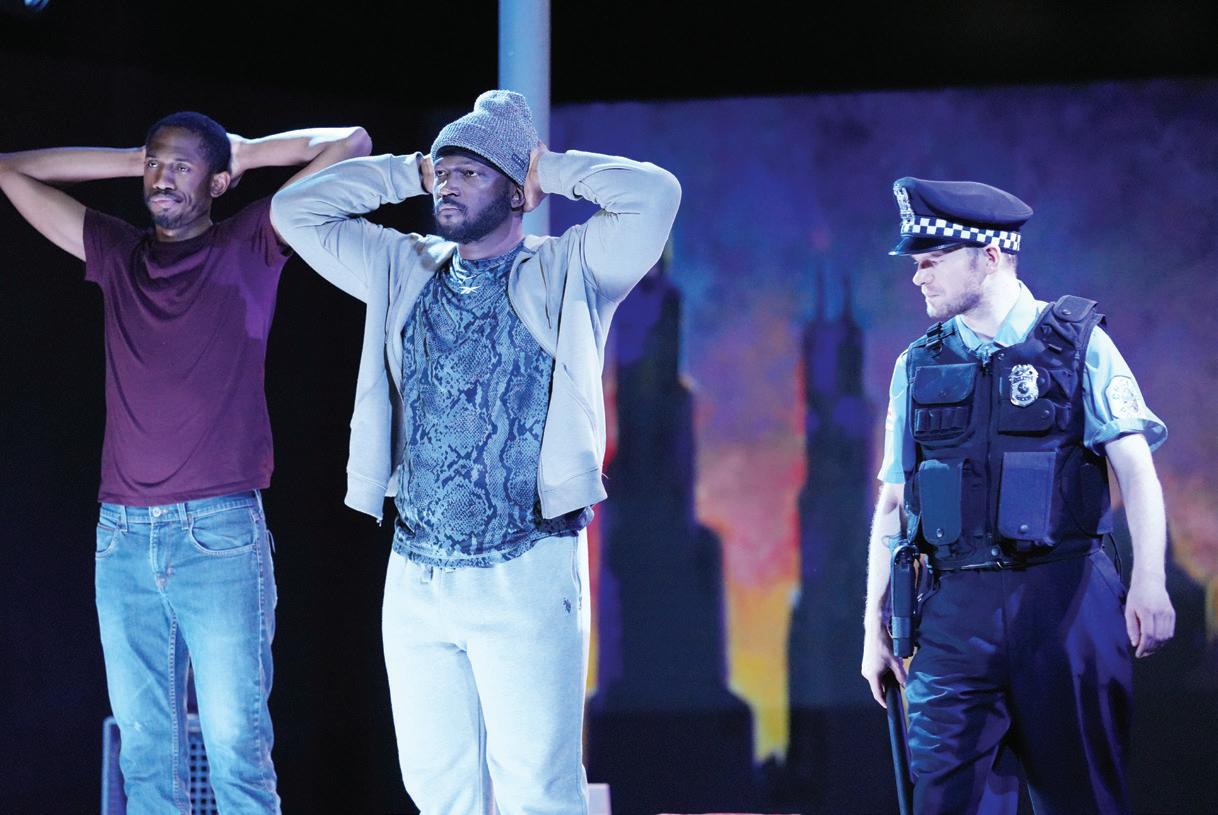
RThe man with Einstein’s brain
Incognito draws on a real-life story to ask questions about the mind and identity.
With just four actors sharing 21 roles, the staging gets understandably creative, with frequent blackouts and rapid accent changes between characters. This is sometimes discombobulating, which fits well with the theme, as identity and memory are explored through the lives of two amnesia patients. One is based on the real-life figure of Henry Molaison (played through his life stages by a shape-shi ing Riles August Holiday).
Outwardly capable neurophysicist Martha Murphy is committed to her work, but struggles to know herself, tinkering with substance abuse. Shannon Leigh Webber flips between Martha and four other characters with grace, even conjuring a spirited New Jersey housewife. Erin Alys does similar magic, sometimes embodying a stoned Australian, sometimes a doting lesbian lover. Lastly, Teddy Boone plays Thomas Harvey, portraying his trajectory from confident young doctor to obsessed old man with conviction. A real thinker of a play, it carries us expertly through wonder and connection without prescribing a fixed reality. —KIMZYN CAMPBELL INCOGNITO Through 8/3: Thu–Sat 7:30 PM, Sun 4 PM; Theater Wit, 1229 W. Belmont, tindrumtheatre. com or theaterwit.org, $25-$39 ($15 students)
RPass Over
retains its power
Fleetwood-Jourdain offers a sturdy revival of Antoinette Nwandu’s breakout play.
In 2017, the world premiere of Antoinette Nwandu’s Pass Over at Steppenwolf Theatre (directed by Danya Taymor) caused a huge stir (and got Spike Lee to pay a visit to Halsted Street to film the production). Now Fleetwood-Jourdain Theatre (FJT) revives the show about Black male bonding and police violence, and it couldn’t feel more timely.
So it’s not the most dramatically complex piece of bio-drama you’ll ever see. But sometimes the choir needs a rousing chorus of encouragement, and there’s plenty of that on display here. The chorus, in fact, is made up of six more women and two men who play all the other roles, navigating the shi s between characters and the mimed tennis action (movement direction by Steph Paul) with ease as the decades unfold off and on the court. An interlude featuring King’s support for trans athlete Renée Richards is particularly timely, given the cynical way many anti-trans activists are pretend-
As is your life. The kids play with an old camera with no film in it, but the pictures of them the world carries are formed by the nasty confluence of capitalism, imperialism, and plain old narcissism.
In Phillip Howze’s 2017 play Frontieres Sans Frontieres, now in a local premiere at Theatre Y under the direction of Kezia Waters, those toxic elements make the dump where the kids live (the script gives the location simply as “Here”) a crucible of competing interests, each represented broadly by a rotating cast of characters who visit.
There’s the seemingly sympathetic teacher, Thom (Cameron Austin Brown), who offers to teach Win English if she promises not to ask him for any more money. There’s a backpacking journalist (Terreon Collins) interested in seeking careerist glory from the misery of others. There’s a doctor from the World Health
Some stories are too strange to be made up, as is the case with Incognito. Nick Payne’s play, directed in its Chicago premiere by Jason Palmer for Tin Drum Theatre, starts with pathologist Thomas Harvey stealing Einstein’s brain. That really happened, and he soon became fixated on the idea that if he just dug around deep enough in the folds, he’d find some physical evidence of genius. It was a rookie mistake to mix up the hardware with the so ware, but it makes for an interesting jumping-off point for a story that asks a lot of questions about the mind and identity.
Payne’s work o en simultaneously explores philosophical questions and scientific wonder while subtly blending in human relationships. With Incognito, we get a chance to see what meaning each character ascribes to their world while also seeing how it impacts their relationships and behaviors.
By switching between narratives and perspectives, this contemporary play attempts to dig just as deep into the human psyche (and some ethical questions about science) as Harvey dug into the so tissue of the brain he stole. To mirror the modern structure of the play, scenic designer Marcus Klein takes a minimalist approach, but there is a big synapse puppet hovering and blinking above to echo the action below.
Written before George Floyd, but a er Laquan McDonald, Eric Garner, Michael Brown, Tamir Rice, and so very many other Black men and boys were killed by police, Nwandu’s play reimagines Samuel Beckett’s Waiting for Godot as a world where two young Black men, Moses (Tyshaun Meekie) and Kitch (Tyrone Norwood Jr.), hang out at the corner of 64th Street and King Drive. As suggested by his name, Moses is the more ambitious of the two and longs to break out of the narrow confines of this world, where a cop (Tiemen Godwaldt) harasses them for the sheer sadistic fun of it (paging ICE).
Godwaldt also plays a white man in a suit and hat carrying a picnic basket who claims to be lost looking for his mother, and shares his lunch with Moses and Kitch. But even this encounter is fraught with microaggressions and menace. (He may seem like Red Riding Hood, but Godwaldt’s Mister, who at one point insists his name is “Master,” would probably be perfectly at home in white hoods.) As in Phillip Howze’s Frontieres Sans Frontieres at Theatre Y (also reviewed this week), alleged do-gooders with their own agendas are o en wolves in sheep’s clothing for dispossessed people.
FJT artistic director Tim Rhoze’s direction keeps the dialogue between the two men humming, and the balance between Meekie’s slightly more choleric Moses and Norwood’s playful Kitch makes for many charming moments. That also makes the build to the dark conclusion even more heart-wrenching. We know, like Estragon and Vladimir in Beckett’s play, Moses and Kitch (or at least other young men just like them) will be back on that corner tomorrow, wondering when they’ll ever get the chance to pass over into a more promising land. —KERRY REID PASS OVER Through 8/10: Sat 7 PM, Sun 3 PM; Fleetwood-Jourdain Theatre, Noyes Cultural Arts Center, 927 Noyes, Evanston, 847-8665914, fjtheatre.com, $32 ($10 students) v
Pass Over BASIL CLUNIE





Quite a bit of what I watch outside my home is movies I’ve already seen. Sometimes the experience can be disappointing (which is not to say bad, but I like variety), and sometimes, like this past week, it can be exciting. First, on Wednesday, I saw Susan Seidelman’s Desperately Seeking Susan (1985) at the Davis Theater. When I told my friend John of the Oscarbate Film Collective that it was my birthday, he asked me if I would introduce the film with him; so I did (and I definitely rambled). What really made it special is that John had asked Seidelman to record an introduction, and in it she wished me—me!—a happy birthday.
Seidelman’s feature debut, Smithereens (1982)—which in 1982 became the first U. S. independent film at the Cannes Film Festival—had been a revelation for me several years prior, when the Chicago Film Society screened it. Then I saw Desperately Seeking Susan and became a confirmed admirer of Seidelman. In these two films specifically, Seidelman depicts protoantiheroines: in Smithereens, the main character, Wren, is particularly unlikable, but in Desperately Seeking Susan she—well, both of them (played by Rosanna Arquette and Madonna, who became a superstar during filming)—aren’t really either good or bad, just two women making their way in the world.
I often say that I know I don’t like a film when I find myself questioning its logic, because ultimately, suspended disbelief and all that doesn’t matter. Inspired by Jacques Rivette’s masterpiece Céline and Julie Go Boating (1974), the film has a wacky plot yet makes total sense. In Seidelman’s New York City, it’s perfectly reasonable that a woman could hit her head, forget who she is, get mistaken for someone else (all because of an ad in the personals, mind you), and then later

NOW PLAYING

Desperately
Seeking Susan
COURTESY ORION
PICTURES
get a job at a magic club after randomly stumbling into it in hopes of discovering her identity. That’s not even a major plot point, merely something that encapsulates the whimsical chain of events.
This logic—or at least an acceptance of a lack of logic—applies also to Francis Ford Coppola’s Megalopolis (2024), which I saw on Friday at the Chicago Theatre with the filmmaker in attendance. I liked it even more the second time around. It’s like a contemporary update on King Vidor’s The Fountainhead (1949), a treatise on progress in both the technological and humanistic senses. The two-hour talk afterward was just as zany, but in a movingly earnest way. (A few weeks ago, during the Q&A following her 2024 film, Castration Movie Pt. 1, filmmaker Louise Weard asked, “Isn’t sincerity the new transgression?”, and I’ve been thinking there’s something to that.) He didn’t want to talk about being a legendary filmmaker. No, he wanted to have an actual discussion with the audience about how to make the world a better place. He even had a whiteboard.
Sincerity is one of my favorite things in cinema. It can elevate the most modest, or the weirdest, or the corniest film to high art. Such a mindset must be applied to what some might deem sleazy or schlocky, such as the work of Spanish filmmaker Jess Franco, whose iconic Vampyros Lesbos (1971) I saw at the Davis Theater, presented by Oscarbate. The film’s sleaziness is its artistry; the women’s at times scantily clad bodies are no di erent from statues in a museum. Until next time, moviegoers. —KAT SACHS v
The Moviegoer is the diary of a local film bu , collecting the best of what Chicago’s independent and underground film scene has to o er.
Happy Gilmore
2
Can countless cameos make a movie? Happy Gilmore 2 thinks so. With Post Malone, Travis Kelce, and even Eminem popping in, this whirlwind comeback story is a guessing game of surprise appearances.
Thirty years a er Happy Gilmore (Adam Sandler) won the gold jacket and got the girl—golf PR director Virginia Venit (Julie Bowen)—life hasn’t been kind. One absurd thing led to another during Happy’s legendary career, leaving him broke and grief-stricken. The oncewannabe-hockey-player-turned-golf-star works in a Stop & Shop and drinks so much booze it makes John Daly (who lives in Happy’s garage) look sober.
Happy still has one thing: his children. His four sons inherited their father’s angry bravado, shown by slapstick fistfights and crude jokes. Meanwhile, his daughter, Vienna (played by Sandler’s youngest, Sunny), dreams of enrolling in a Parisian ballet school at the high price of $75,000 per year. Yikes.
Can Happy make this money by returning to his defamed golfing career? Daly thinks so. Happy starts from the bottom, playing a comically bad round of golf with Margaret Qualley, Martin Herlihy, and Eric André, before a literal crash out sends him to AA. Soon a er, he starts playing some real golf with his new caddy (Bad Bunny). Perhaps the only good thing is that everyone looks like they’re having fun.
The adversary of the film (other than outrageous college tuition) is found in Frank Manatee (Benny Safdie), CEO of Maxi Energy Drink and its golf league, which wants to transform golf into an extreme sport. For the love of golf, five traditional golf players, including Happy, take on the league to save golf—and win Vienna her ballet money. We get some light chuckles and one-off jokes, but the story, with bones to be genuinely gripping, flatlines thanks to an onslaught of half-assed gags and cameos.
Happy Gilmore 2 is a party for those involved, but it relegates its audience to the sidelines. We can revel in the fact that everyone on set—from all the big-name celebs to Sandler’s own family—appears to be having fun, but this is yet another sequel buoyed more by star power than substance. —MAXWELL RABB PG-13, 114 min. Netflix
R Together
If you’ve never been in a long-term relationship where your lives grow so entangled it feels impossible to sever yourself from your partner, you’ve at least told one such couple to cut each other loose. There’s a thin line between intimacy and interdependence—and it’s precisely this line that Australian director Michael Shanks walks in Together . This romantic body horror gives grotesque shape to the unraveling of intimacy, where love and dependency knot into something suffocating but tender nonetheless.
We meet Millie (Alison Brie), pragmatic and kind, just as she’s ready to start her life as a schoolteacher in the countryside. She is self-assured about the move—leaving behind friends and metropolitan life—but her longtime boyfriend, Tim (Brie’s real-life husband, Dave Franco), holds reservations. This laid-back thirtysomething clings to a fading dream of music stardom. One partner grows up; the other stalls out.
What makes this asynchronous relationship so tricky (and so relatable) is that the love is entirely real. The sincerity of each character—fortified by the stars’ real-life marriage—grounds Together in an emotional truth that lets love twist into something horrifying yet magnetically compassionate.
Before Shanks injects us into Tim and Millie’s relationship, Together lays out its mythology in plain terms. A damning prologue tells a story about a couple who vanish close to Tim and Millie’s new house. While combing the woods, two dogs discover a strange body of water beneath a bell and destroyed church pews. That night, after drinking it, the dogs’ heads fuse together. When Millie and Tim fall into the same culty cave and drink from the same water source, we are well prepped for what’s about to happen.
There’s no attempt at subtlety, nor should there be. Shanks opts for blunt, mythic storytelling, letting the strangeness emerge plainly. That assuredness is what grounds the film’s wildest swings. Tim begins to feel physically tethered to Millie. One of the film’s best sequences captures this connection viscerally when, from a bird’s-eye view, Franco crashes against the shower wall just as Brie drives further away. It evolves into a “full body thirst” nurtured in both, a need that’s terrifying and erotic.
Together leans into the grotesque pleasures of watching the transformation unfold. Like The Substance, it trusts the audience to grasp the metaphor and revel in the squirm-inducing details. Still, at its core is a relationship that feels disarmingly sincere. Even as their physical boundaries coalesce, Tim and Millie care for one another. They’re best friends in the thick of unraveling, their love tender and lived-in, even as it mutates into something unknown. —MAXWELL RABB R, 102 min. Wide release in theaters v
Together COURTESY NEON
The Food & Drink Issue

What K-Smoove brings to the table
In the 90s, Kevin Woodard helped hold the west-side scene together as a rapper. Now he’s doing the same thing with the “Chicago-style turkey” at KS Sandwiches.
By LEOR GALIL
Ididn’t expect to find a new favorite specialty sandwich shop through an Instagram account dedicated to obscure regional rap cassettes and CDs. But on June 6, 2023, a Pittsburgh collector who documents old hiphop releases under the name Factorz in tha Game posted photos of 4 Da Monez’s, a 1995 cassingle by Wax Master (aka ghetto-house DJ and producer Waxmaster Maurice) and rapper K-Smoove. In the Instagram comments, Waxmaster Maurice tagged CookinDaFlava, an account that belongs to K-Smoove, aka Kevin Woodard. Within a few days of that Factorz in tha Game post, Woodard opened a restaurant in East Garfield Park called KS Sandwiches— short for Kevin’s Signature Sandwiches. At that point, I only knew a little about Woodard’s career as a rapper, but I was al-
ready intrigued. He’d helped originate the “chopper style” that dominated the west side in the 1990s, alongside the likes of Do or Die, Crucial Conflict, Psychodrama, Twista, and Triple Darkness. His rapping was smooth and fast, with sudden, liquid shifts in tempo, but the national success achieved by some of those other Chicago acts eluded Woodard. He released a handful of singles, EPs, and albums on cassette and CD through independent labels, and then he moved on from music in the early 2000s.
Woodard’s old recordings, all long out of print, can sometimes sell for north of $100. On Discogs, the cheapest currently listed copy of the 1996 K-Smoove album Da Plan (also styled Tha Plan) is a $39.99 CD at Hyde Park Records. The most expensive is 800 euros plus ship-
ping. A brief listen to Woodard’s music makes it clear why collectors care: On “Hustl ’in, Pimp ’in, Mack ’in,” from 1995’s Pimp or Die, his voice leaps like a coiled spring. “K’s gonna be timeless to us,” says Corin Federick, aka Psychodrama rapper NewSense. “He was our first street griot.”
I made my inaugural visit to KS Sandwiches at the end of June 2023. At the time, its menu consisted of just two items, both of them variations on what Woodard calls a “Chicago-style turkey sandwich.” It’s essentially an Italian beef made from a di erent animal. If a dipped beef sits in your guts like a brick, you might want to try Woodard’s flavorful reinterpretation—my stomach doesn’t have any trouble with it. The sandwich has also impressed Samill “DaWreck” Johnson of Triple Dark-
Kevin Woodard plays a video starring himself on a TV behind the counter at KS Sandwiches, 2912 W. Madison. The shop is usually open Fridays and weekends—check instagram.com/cookindafl ava for hours. KIRK WILLIAMSON
ness. “I was shocked,” he says. “I was like, ‘Wait, this tastes like an Italian beef to me, but lighter and fresher.’”
KS Sandwiches has expanded its menu a bit since 2023, and Woodard just introduced a vegetarian version of his sandwich. His hours remain limited: The shop is open only on Fridays and weekends, though you may want to double-check before visiting. (One Saturday afternoon, I found the gates closed.) Woodard often posts on Instagram when KS Sandwiches is open for the day. These hours are a deliberate choice, to help keep the operation manageable. “I always wanted a shop just to display my styles and my flavors,” Woodard says, “but I didn’t want a traditional restaurant, where it relies on a whole bunch of people to make things happen.” Woodard bought a building at 2912 W. Madison in 2016 and gut rehabbed it. That building houses another Woodard business venture, an events space called Flava Luxx, and KS Sandwiches occupies a shipping container in the western side yard. The restaurant is essentially a walk-up window with outdoor picnic tables, and because Woodard owns the property and also makes money with Flava Luxx, he’s able to treat it as a casual side hustle—something he can pursue on his own terms. “Early on I figured, like, this my dream,” he says. “Usually you can’t throw your dream on people.”
Woodard took to cooking before he ever picked up the mike. As a kid in the 1970s, he lived around West Fifth Avenue and South Whipple, near Madison and Sacramento in East Garfield Park. After school, he spent a lot of time at his grandmother’s place nearby—he says his mom would send him there when he acted out, and he often ended up in the kitchen. “I used to even go to the stores with my grandma,” Woodard says. “I knew how to pick greens when I was seven, maybe eight.” Around that time, Woodard and
HIP-HOP CHEF
his family moved to the nearby Rockwell Gardens housing projects.
Shortly after Woodard started high school in fall 1984, he caught a hip-hop tour called Fresh Fest at the UIC Pavilion. The bill included Run-D.M.C., the Fat Boys, and Kurtis Blow— and the Fat Boys had a beatboxer onstage. “I was with my best friend, Ron Wilkins—we used to pop-lock and all that stuff together,” Woodward says. “I told him, ‘Hey, I could do that.’”
Wilkins was skeptical, but the next day, Woodard showed him his beatbox skills. Wilkins told Woodard he could rap, and they set about forming a group. They’d call it the Village Crew, after a nickname for the ABLA Homes, where another bandmate lived. At shows, Woodard beatboxed behind the Village Crew’s MCs, which gave him intimate insight into how each one operated on the
mike. This prepared him to strike out on his own a few years later.
The Village Crew’s DJ was another pal of Woodard’s from Rockwell Gardens: Maurice Minor, aka Waxmaster Maurice. “I was a young guy, so it was fun,” Minor says. “They had dancers and all that—[we played] little neighborhood shows and talent shows.”
“I always wanted a shop just to display my styles and my flavors, but I didn’t want a traditional restaurant.”
Minor and Woodard also shared an after- school job at Oak Park Hospital.
Woodard says food-services company Sodexo hired him in 1987 for a job in the storeroom, and he and Minor later worked together in the kitchen.
Minor recalls that Woodard could cook a mean dish out of whatever random ingredients he had on hand. Woodard stuck with Sodexo as his music career evolved, climbing the ranks at the hospital over the
course of nine years and eventually moving on to other locations.
In the late 1980s, the Village Crew signed with West Madison Street Records. The group issued a couple songs through the label: “Step to This Tune” appears on the 1988 compilation Hoe-Down, and “War” came out as a cassette single in 1989. (Woodard and his bandmates took the cover photo on a bridge leading to Rockwell Gardens.) The group flamed out before “War” was even released, but Woodard had already refocused on a solo career as K-Smoove.
Woodard traces the start of his solo career to a talent competition at Malcolm X College that he won in the late 1980s. He was already performing around town, and his prize included the chance to record a single. He cut eight more tracks for his debut EP, Pimp or Die, which arrived in 1995. “I put a tape together,” Woodard says.
For his solo shows, Woodard brought along a couple dancers. “We got so popular that all the little nightclubs that we could get into,
we didn’t have to pay, we could get in front of the line—so you got that taste of stardom,” he says. “And then when we outside the clubs later, we rappin’. Back then, they used to have a spotlight—like the whole street, up and down Madison Avenue, like they do in LA, where the cars parked from Cicero all the way back to Homan. We used to walk up and down sellin’ CDs, but also perform, like, in the middle of the street.”
Woodard’s reputation as a solo artist spread throughout the west side. “I heard some of his songs—that was, like, the first underground rapper I heard that had tapes and stu out,” DaWreck says. “He was talking about stu that I knew about and the area that we lived in, and the language that he spoke was the same language that we spoke—so it was real relatable.”
“He was the first person that I knew that was teaching the way the streets really are through music,” NewSense says. “Some people would talk about streets one-sided, but he had a holistic view on it. He was the first rapper that I knew from Chicago that would give game through music. The only other person

The Food & Drink Issue
continued from p. 19
that I knew that was really good at that was Scarface, but he’s from Texas.” NewSense and DaWreck contributed to K-Smoove’s 1998 album, Thru da Eyez of a
dance music,” he says, “I ended up quitting the hospital.”
Woodard was still working for Sodexo, which gave him the financial cushion to pursue music. While the west-side sound that

Playa ; DaWreck also made an appearance on 1996’s Da Plan. The late 90s were a boom time for Chicago’s west-side scene. Crucial Conflict’s 1996 debut album, The Final Tic , peaked at number 12 on the Billboard 200 thanks to the breakout single “Hay.” Do or Die recruited Twista for the track “Po Pimp,” which reached number 22 on the Hot 100 in August 1996. Minor’s reputation in Chicago’s dance scene also blew up internationally, thanks in part to material he’d issued through ghettohouse label Dance Mania. Daft Punk’s track “Teachers,” from the 1997 album Homework, liberally borrowed from the 1995 Wax Master collaboration with Parris Mitchell, “Ghetto Shout Out!!” Right at the top of the song, Daft Punk name-checks several Chicago dance legends, including Wax Master. “I had started doing so good, as far as my mixtapes and the
he helped shape became a national phenomenon, Woodard’s rap career also seemed to be getting traction outside the city. He inked a deal with Success Records, a Georgia label distributed by Ichiban. Success founder Chris Jones was executive producer on Thru da Eyez of a Playa, but he died before Woodard’s next record. “Chris Jones, bless his soul,” Woodard says, “he was a heavyset gentleman. He had twisted his ankle all the way around—his foot was turned backwards, and they had to turn it back straight. It created a blood clot that traveled up to his heart. That killed that deal.”
Woodard’s final album was 2002’s Focus . He’d planned their three titles to spell out a sentence. “If you put it all together, it’s Thru da Eyez of a Playa da Plan Is to Focus ,” he says. “On the next shit. That was my thing.”
Things I Can Do With Two Hot Chicks. “That title got me on TV several times,” he says.
“I think Channel Nine news in Chicago, they was interviewing him,” says Marrico “Never” King of Crucial Conflict. “And he was on there, live, preparing the foods. I was, like, ‘Whoa, that’s the homie from the neighborhood.’ That was my first time even knowing he was a chef or can cook like that.”
As Woodard focused more of his creative energy on food, his hip-hop friends showed up for him. DaWreck designed the cover for Things I Can Do With Two Hot Chicks and helped film and edit episodes of a hip-hop cooking show that Woodard pitched to TV One. When Woodard became a private chef in 2013, the first person to hire him for an event was Robert “Lil Rob” Flynn of Chicago rap group Snypaz.
“He’s my only choice, for anything and all things that needs catering.”
—Corin Federick, aka NewSense of Psychodrama

Stardom eluded Woodard, but that wasn’t the only reason he backed away from music in the early 2000s. He’d been left to care for his older sister’s two kids after she died of an aneurysm, not long before Focus came out. “I told myself, ‘You gon’ need to hit it with this one, or you gon’ have to buckle down and see what’s happenin’,” Woodard says. “So that’s when it was the birth of the hip-hop chef.”
Woodard stuck with Sodexo for decades, transitioning from a role as executive chef to an administrative position and eventually becoming a production manager. “My final account was Loyola Stritch School of Medicine,” Woodard says, “I ran that whole campus.” He thanks his “Sodexo family” for “a great start in food management” in the acknowledgments of a self-published 2014 cookbook of rotisserie chicken recipes. The cover photo shows Woodard holding a plated chicken in each hand, and the book is called
“In 2022, I threw a ‘living legends’ celebration for George Daniels [of west-side record shop George’s Music Room] at the Promontory—K-Smoove was our cook,” NewSense says. “He’s my go-to, so that says a lot about him, not only as a chef but his professionalism. Because anybody can cook, but that don’t mean you want any cook around your people, around your events. So the fact that he’s my only choice, for anything and all things that needs catering, that says a lot.”
Woodard developed his Chicago-style turkey sandwich while catering events, and he’d offer to throw them in gratis along with whatever his customers ordered. Now he sells turkey sandwiches on the same property where he throws private events, often for his friends in the scene. When I spoke with Woodard at the end of June 2025, he’d just hosted a birthday party for DaWreck’s grandma. Plenty of his friends from the scene have made use of Flava Luxx, and a few years ago, he let Never film a video for Saint Louis clothing brand Alpha Preneur on his rooftop chessboard.
“He’s part of the brotherhood,” Never says of Woodard. “There’s a group of us—like, we all artists, we do something, whether we sing, rap, or [we’re] just good with networking with people. But we all hang out, and we share ideas.” When Never bought a new sewing machine earlier this year, he says, he was inspired by the praise Woodard had given to a clothing line Never launched decades ago.
“I’m elated to be a part of the brotherhood and a friend of Kevin,” Never says. “I’m glad to be a part of what he brings to the table.” v
m lgalil@chicagoreader.com
Kevin Woodard poses with the mural next to KS Sandwiches, on the west wall of Flava Luxx. KIRK WILLIAMSON
Recommended and notable shows with critics’ insights for the week of July 31
PICK OF THE WEEK
Australian psych-rock bruisers King Gizzard & the Lizard Wizard meet the Chicago Philharmonic


ANIMATED AUSTRALIAN PSYCH ROCKERS
King Gizzard & the Lizard Wizard are touring on their orchestral album Phantom Island, released in June via their p(doom) label. But they’re so staggeringly prolific that before this gets published they’ll probably drop, I dunno, a triple LP inspired by West End Records’ late-70s disco albums. In the 15 years the six-piece have been active, they’ve experimented with prog, dance, metal, hip-hop, Krautrock, funk, and more across 27 studio albums. Discogs lists nearly 100 King Gizzard albums (plus 70 compilations), because it’s counting high-quality live recordings made by the band and released by fans and indie labels at the band’s encouragement. According to Billboard, King Gizzard doesn’t ask for a cut of sales from these recordings—just some physical copies. They include Live in Chicago ’23, from King Gizzard’s three-night stand at the Salt Shed, whose formats include sets of eight LPs and six CDs.
King Gizzard’s open-armed embrace of this fan “bootlegging” has helped them develop a massive cult following, unrivaled by any other group of their era. This phenomenon—and the band’s tendency to unspool their songs into ultra-extended live versions—has gotten King Gizzard labeled a jam band, but the more you listen, the less apt that
seems. Yeah, some of their melodies could pass for especially doofyass Lettuce tunes, and their set lists definitely assume you don’t have anywhere else to be, but King Gizzard play harder than any jam band. Their brilliantly dumb ri s arrive with enough speed and force to wake the dead. On my favorite King Gizzard album, 2023’s PetroDragonic Apocalypse; or, Dawn of Eternal Night: An Annihilation of Planet Earth and the Beginning of Merciless Damnation , their muscular, proggy chugging borrows from the New Wave of British Heavy Metal. It’s easy to imagine the band riding one of these galloping songs for days, but they maintain such a combustible focus and drive that they could chase down Cerberus.
I’m less wild about Phantom Island, though I appreciate its ambition. King Gizzard collaborated with conductor and pianist Chad Kelly, whose orchestral arrangements don’t do much more than accentuate the fanciful material. Given that King Gizzard already make music worthy of opera houses, these symphonic touches feel uncharacteristically timid. I hope the Chicago Philharmonic, who’ll accompany King Gizzard at Ravinia, can match the band’s outrageous energy and silliness.
—LEOR GALIL
THURSDAY31
Lollapalooza day one See also Fri 8/1, Sat 8/2, and Sun 8/3. Today’s headliners are Tyler, the Creator and Luke Combs, and the rest of the bill includes Cage the Elephant, the Blessed Madonna, Glass Beams, Ratboys, and DJ Heather. Complete lineup at lollapalooza.com/ schedule. Noon, Grant Park, 337 E. Randolph, one-day platinum tickets $2,130, wait list or verified resale available for many other ticket options. b
The world’s biggest live entertainment promoter, Live Nation, produced Olivia Rodrigo’s 2024 tour in support of her second album, Guts . The tour included two Chicago shows that March, both at the United Center, which hosts Live Nation events. At the start of the tour, Chicago tickets cost north of $200, and high demand led to outrageous price spikes—Forbes reported on a fan who spent nearly $2,000 on two seats. Tickets were initially available only through Ticketmaster (which merged with Live Nation in 2010), and once shows sold out, hopeful attendees could face even bigger markups from resale platforms, which included . . . Ticketmaster. Rodrigo is also a headliner at this year’s Lollapalooza, the Chicago-based megafest organized by C3 Presents, which was acquired by Live Nation in 2014. Lollapalooza used to be a guaranteed sellout: In 2014 and 2015, it sold out weekend passes before even announcing its lineup. A er that, though, sales began to slow, and last year you could still buy oneday passes within 48 hours of gates. This Lolla lineup is one of the worst in recent memory, a wasteland of frat rappers (Ian), Temu yacht rock (Wild Rivers, Ocean Alley), bros named Landon (specifically Conrath and Barker, the latter of whom is the nepo baby of Blink-182 drummer Travis), and Spotify wallpaper pop (exemplified by Djo, aka former Chicagoan Joe Keery, who plays Steve from Stranger Things and recorded perhaps the strangest hit about Chicago, “End of Beginning,” which has the personality of an O’Hare phone-charging station). That said, once tickets to this year’s Lollapalooza hit the market—two days after the lineup announcement in March—four-day passes sold out in an hour.
Those off-the-charts ticket prices for the Guts tour might have something to do with this. If you’re only interested in Lollapalooza because you want to see a big name or three—Rodrigo, pop star Sabrina Carpenter, K-pop act Twice—then $415 for a fourday pass doesn’t look like such a terrible deal. Live Nation bears most of the responsibility for this mess: Now that the company has made its shows at United Center or Soldier Field so expensive that you’ve gotta sublet your apartment for months to afford one, Chicago’s biggest music festival seems almost reasonable by comparison.
Of course, Lollapalooza still has its powerful defenders: If you’re a politician desperately trying to seem cool, a Chicago tourism group that spends too much money devising nonsense slogans, or the conservative editorial board of a local daily newspaper, you might find it in your heart to praise the festival’s economic footprint. But I don’t like live music more because it’s profitable, especially when fans’ money gets funneled to people who aren’t the musicians. And the actual experience of attending Lollapalooza is dreadful enough to make me resent the fact that
KING GIZZARD & THE LIZARD WIZARD WITH THE CHICAGO PHILHARMONIC, DJ CRENSHAW
Wed 8/6, 7 PM, Ravinia, 201 Ravinia Park Rd., Highland Park, $55 general admission. b
JASON GALEA
MUSIC
continued from p. 21
it has booked a handful of acts I’d actually like to see. (Highlights this year include Chicago R&B star Ravyn Lenae, local alt-country four-piece Ratboys, experimental pop artist Jane Remover, and nu-metal grandaddies Korn.) I’m also baffled that so much of Chicago unquestioningly supports the festival, since it’s patient zero for the temporary privatization of the city’s public parks during the summer months. The “teen takeover” phenomenon has prompted plenty of folks to debate when and how teenagers should be able to access public spaces downtown, but these concerns seem to evaporate when it comes to a ticketed megafest, ostensibly for teens, that’s owned by a multinational repeatedly accused of monopolistic behavior. (This surely couldn’t be because Lolla draws so many white kids from the suburbs.) To paraphrase a famous quote Mark Fisher adapted for the 2009 book Capitalist Realism , it’s easier for me to imagine an end to free public access to Grant Park than an end to Lollapalooza. No one should have to pay—or slog through Lollapalooza—to see a beautiful August sunset through the city skyline from Grant Park. —LEOR GALIL
FRIDAY1
Lollapalooza day two See Thu 7/31. Today’s headliners are Korn and Olivia Rodrigo, and the rest of the bill includes Djo, T-Pain, Ravyn Lenae, Otoboke Beaver, and Jane Remover. Complete lineup at lollapalooza.com/schedule. Noon, Grant Park, 337 E. Randolph, one-day platinum tickets $2,130, wait list or verified resale available for many other ticket options. b
SATURDAY2
Lollapalooza day three See Thu 7/31. Today’s headliners are Rüfüs du Sol and Twice, and the rest of the bill includes Clairo, JPEGmafia, Flux Pavilion, Wasia Project, and Ca7riel & Paco Amoroso. Complete lineup at lollapalooza.com/schedule. Noon, Grant Park, 337 E. Randolph, sold out, wait list or verified resale available for many ticket options. b
Patrick Shiroishi See also Sun 8/3. Sumac headline; Chepang and Patrick Shiroishi open. 8 PM, International Museum of Surgical Science, 1524 N. Lake Shore Drive, sold out. 17+
Patrick Shiroishi is a familiar name in jazz and improvised music. Based in Los Angeles, he’s constantly recording and collaborating with artists far afield (perhaps most notably with the Armed, Claire Rousay, and Xiu Xiu), and though he’s a multiinstrumentalist, he’s best known for his saxophone work. Alto, baritone, sopranino—he likes all kinds of saxophones, delighting in how their reeds transform his breath into toots and squelches and how their keys transform the motion of his fingers into thumps and clicks. Unlike some modern saxophonists, such as Colin Stetson or Bendik Giske, Shiroishi doesn’t emphasize the physicality of the instrument, but he does like to push its range.
On the 2020 release Eye for an Eye (Armageddon Nova), a 35-minute recording of a 2019 performance at Shiroishi’s home studio, his sopranino sax moves in flutters and bursts, teasing melo dic phrases between playful passages that wander like an over caffeinated butterfly. On his self-released 2019 record 勉強 (which translates to “Study”), he plays alto on a piece by Austrian composer Radu Malfatti, whose philosophy strikes Shiroishi as “very Japanese.” On the Bandcamp page for the album, Shiroishi writes, “He wasn’t thinking of filling all of the space or ‘What else can I do next,’ but more of listening to the other sounds for the duration of the piece, that there shouldn’t be a need to feel like something is missing but more of an opportunity to be listening to other sounds.” He recorded the piece in his bedroom, capturing his ideas like a sketch—a process he describes as his “benkyou” or “homework.” While this recording isn’t as ephemeral as a show, it’s also not as worked-over and polished as something made in a traditional studio—and that’s the point. Shiroishi is primarily interested in making, sharing, and exploring. Whatever refinement happens is secondary to that act of curiosity and connection through sound.

makes music as Otay:onii), speaks to the album’s themes of confronting the intergenerational scars of racism and colonialism. Shiroishi has announced a solo tour that stops in Chicago on November 7, but for these dates, he opens for the mighty Sumac— whose front man, Aaron Turner, appears on three tracks of Forgetting Is Violent —MICCO CAPORALE
SUNDAY3
On July 24, Shiroishi released “There Is No Moment in My Life in Which This Is Not Happening,” the first single from the new studio album Forgetting Is Violent, due September 19 on American Dreams. This aching, haunted meditation, with vocals by Lane Shi Otayonii of Elizabeth Colour Wheel (who also

Lollapalooza day four See Thu 7/31. Today’s headliners are Sabrina Carpenter and A$AP Rocky, and the rest of the bill includes the Marías, Remi Wolf, Isaiah Rashad, Rebecca Black, and Kaicrewsade. Complete lineup at lollapalooza.com/schedule. Noon, Grant Park, 337 E. Randolph, sold out, wait list or verified resale available for many ticket options. b
Patrick Shiroishi See Sat 8/2. Sumac headline; Chepang and Patrick Shiroishi open. 9 PM, Empty Bottle, 1035 N. Western, $26.78. 21+
TUESDAY5
Family Junket 5:30 PM, Museum of Contemporary Art, 220 E. Chicago, walk-up admission starts at 4:30 PM, capacity limited. F b
Few things relieve the grind of modern life like letting loose with your pals—and the fun is even more cathartic when you can turn it to creative ends. That seems to be the modus operandi of Chicago band Family Junket. They list 12 musicians in the credits of their debut EP, May’s Did You Tell the Bees?, but outfits this size are usually a bit catch-as-catch-can when it comes to filling out a lineup. The consistent core of Family Junket is an eight-piece group consisting of vocalists Clarence Young and Rahila Coats,
Find more music listings at chicagoreader.com/musicreviews

drummer and percussionist Hasani Cannon, guitarist Alejandro Gallardo, strings player Scott Daniel, and three brothers Lazarus: bassist and guitarist Zach, drummer and percussionist Jonah, and keyboardist, guitarist, and winds player Max. They sprinkle their exuberant collisions of neosoul, funk, and R&B with spacey textures and touches of psychedelia, and the joy they take in making music together bursts through every note. My favorite track, the minutelong “Hasani’s Axiom of Love (As It Pertains to the Cuttlefish),” pairs slam-style spoken word—about searching for love, from the surface of the sea down to its depths—with a bright, pulse-quickening duel of drum kit and hand percussion by Cannon and Jonah Lazarus. That leads directly into the heavy funk of “Time Is What I Need,” whose titular sing-along refrain and cosmic cacophony feel like they evolved out of an especially wild jam session. The big horn arrangement, sprightly flute, and sunny grooves of “Buzzin” recall vintage R&B and funk, and the band lean into serene intimacy on the soulful, earthy “Root.” The variety of sounds and moods on Did You Tell the Bees? prove Family Junket to be the kind of band that can adapt to any idea they seize on, and it’s exciting to imagine where they might chase their muse next.
—JAMIE LUDWIG
WEDNESDAY6
Brea Fournier & the Dream Ballet Violet Crime, Cat Merkle, and Madame Reaper open. 8 PM, Burlington Bar, 3425 W. Fullerton, $16.08. 21+
The “manic pixie dream girl” archetype is one of the most embarrassing cultural trends of this century. Though usually presented as a modern, independent woman, the MPDG is little more than a vector to guide a male protagonist toward self-discovery, with no inner life or identity of her own. Only her soundtrack (indie rock suitable for an Apple commercial) and her haircut (lots of bangs and bright-
Ratboys (le ) and Jane Remover are among the highlights at this year’s Lollapalooza. ALEXA VISCIUS, BRENDON BURTON
Patrick Shiroishi SAM LEE
CHICAGOANS OF NOTE

ly colored dye jobs) differentiate her from other two-dimensional female character tropes—the nerdy girl who turns out to be hot when she takes off her glasses, for instance, or the damsel in distress who can actually throw a punch. Film critic Nathan Rabin coined the term in 2007, and Idaho-born singersongwriter Brea Fournier says that the notion of the MPDG persists in the urban dating pool to this day—which she discovered after moving to New York in 2018 to study music at Tisch School of the Arts. “I started having the same experiences with men over and over again where they treated me as if my free-spirited personality only existed to seduce them, and then they were extremely taken aback when they realized that’s just who I am,” she told music blog A Grrrl’s Two Sound Cents last year. At school she learned about the MPDG from her filmmaker friends, and a light bulb went off in her head. As she said in an interview with Indie Music Discovery, “I knew I had to be the one to finally write a story in which she could finally exist as the main character.” That story took the form of 2024’s Manic Pixie Dream Girl! , the 12-track debut album by Fournier and her band, the Dream Ballet. It’s a borderline rock opera that mixes pop punk, indie rock, new wave, and alt-pop, with lyrics that relate a loose narrative of a manic pixie dream girl who wakes up to the harm her relationships are doing to her sense of herself and breaks free to live on
her own terms. Fournier has said she found the writing process cathartic, and the emotions and vulnerabilities she describes draw from her own gendered experiences: unfulfilling or even exploitative situationships, internalized beauty standards, the pressure to get married or otherwise conform to gender roles. “The Masochist” opens with an escalating spokenword passage where the narrator confesses her addiction to dating men who shower her with attention but don’t take her seriously. On “Petty Stuff,” though, she shakes off the bullies, exes, and insecurities to become her own biggest fan. Produced by Barb Morrison (Debbie Harry, Rachael Sage, Gina Volpe), the album has a squeaky-clean pop sheen, and some songs feel like story glue, not intended to stand on their own. Combined with Fournier’s vocals, which she consistently aims at the ra ers, this makes Manic Pixie Dream Girl! sound less like a rock album and more like the cast recording from a Broadway musical. But I bet that once Fournier and the Dream Ballet get onstage at the Burlington, you’ll have a much easier time hearing their rage.
Worldrenownfailure, punk videographer
“I was sitting on so much footage that I was like, ‘I might as well just upload this to YouTube in case the band wants to see it.’ At that point, bands started reaching out to me.”
As told to LEOR GALIL
—JAMIE LUDWIG
King Gizzard & the Lizard Wizard with the Chicago Philharmonic
See Pick of the Week on page 21. DJ Crenshaw opens. 7 PM, Ravinia, 201 Ravinia Park Rd., Highland Park, $55 general admission. b v


In June 2023, a Chicago videographer who goes by Worldrenownfailure uploaded three clips of bands he’d shot playing at Gman Tavern to his YouTube page. Since then, Worldrenownfailure has done impressive work documenting the grungier corners of Chicago’s sprawling underground rock scene. The roughly 300 clips on his YouTube page include plenty of locals who’ve already attracted some buzz—among them hardcore outsiders We Weren’t Invited and pop-punk band Scarlet Demore—as well many others who may never get attention anywhere else.
Worldrenownfailure shoots exclusively using a Toshiba SK-F200 VHS camcorder, a model introduced in the late 1980s. This makes his work look like video of punk shows from 30 years ago—low resolution, contrast problems, lens artifacts, and all—and it’s quickly earned him a reputation among young Chicago musicians. Worldrenownfailure has recruited friends Karina Avitia and N.T. Hari to help him shoot concerts, and in early June, he and Hari launched a monthly YouTube-based variety show called Viewfinder. The series isn’t exclusively about music—in episode one, they visit C2E2 and interview fans and exhibitors—but its foundation is rock.
It
first started o as just me, going around shooting concerts, but eventually it evolved into my friend N.T. Hari and my friend Karina [Avitia]. We have a little team going around and basically trying to show all the art that Chicago has to o er— so artists, vendors, promoters, stu like that. When I was working at Cole’s, my friend would always offer to take me to her boyfriend’s shows. One day I finally went, ’cause there was one right down the street at a place called the Extraordinarium. It no longer exists; a lot of the bands from that show no longer exist. But it was really eye-opening, ’cause there were so many people packed into this tiny toy store—and a lot of people were having fun, singing along. I had no idea who these people [were], but just that little taste made me want to get in there and become a part of
-
Family Junket GRACE KERPAN AND ELAINE MILLER
Brea Fournier & the Dream Ballet CARLO D
Worldrenownfailure and his VHS camcorder MATT BRADY
MUSIC
continued from p. 23
that community.
One day, [another] friend gave me his grandpa’s old VHS camera. It was still working 100 percent fine. I just decided to take it to a show and record little bits and pieces. At first I had no intention of recording full sets; I just wanted to make cool little edits and show o . But I realized I was sitting on so much footage that I was like, “I might as well just upload this to YouTube in case the band wants to see it.” At that point, bands started reaching out to me, asking if I can film their set, because it looks cool. Despite these cameras being super old, they actually [do] pretty well at capturing audio.
My family was never able to a ord Blu-ray or DVDs. We just had whatever VHS tapes I was born with. That was my comfort. That’s
experience, especially over time, seeing how Logan Square has changed. I got to see it grow to all these di erent pop-up shops and all this di erent stu —especially these thrift stores, going in and seeing what they might have. People will always donate their old cameras or old VHS tapes. Sometimes what I like to do is go into an old vintage shop, find a random, unmarked tape, and come home and play it. It’s kind of interesting seeing some family who decided to donate their VHS tape.
Iwas talking to this girl, and she ended up ghosting me. I decided to go to a show because we were supposed to go on a date that day. One of the sets [I shot] from that show ended up going viral. The singer of the band, Cheerleader Roadkill, is really popular on TikTok, and when he reposted [the foot-
ple other people shooting with VHS around Chicago—I don’t want to say I’m the person that invented it—but people always kind of tie it in with me.
Like I said, everything we do is shot on physical VHS tapes. To get the tapes to digital, you have to use a certain type of converter. The thing with VHS is, it doesn’t shoot in frames—it shoots in a thing called fields. Since it was supposed to be displayed on those old analog TVs—if you look closely on those old TVs, you see a bunch of lines, and the odd lines and the even lines show a different image, so when you see it move, it flows a lot clearer. So you have to have a converter [that] can keep the fields intact. A lot of this software is old—a lot older than me, I tell you. But getting a good converter and a good VHS system is good.
“Even though people nowadays don’t know what a VHS tape is, they like looking at it, because it’s something different than what’s highquality and what everyone else is doing.”

what I was used to. People always like looking at [VHS] ’cause it looks nostalgic—it looks like something from when they were a kid. Even though people nowadays don’t know what a VHS tape is, they like looking at it, because it’s something di erent than what’s high-quality and what everyone else is doing.
I grew up in Chicago; I’ve lived here my entire life. I’ve only moved around once. I used to live in Wicker Park, and now I live in Logan Square. These neighborhoods have a lot of community and diversity in them. I got to
age], everyone started flooding my YouTube video. It’s still my most popular video. More people started going to other videos. I was like, “I could do this on a weekly basis, and people would get all this recognition.” I reached out to a band called One Step Closer. They were playing a show, and I asked if I could film. They said “Totally!” and ended up using one of the videos to promote an upcoming show. And so I realized people can use this for music videos, music for promoters. People will always recognize it as my stu . There’s a cou-
What I do is, I basically run [the footage] through OBS, ’cause it can record what my VCR plays. [Editor’s note: OBS Studio is free open-source software for livestreaming and video.] Basically I have to rewatch everything I do in real time. So if I shoot a 20-minute set, I have to stay at my computer 20 minutes and make sure everything goes good—make sure the picture comes out clear, the video and audio comes out clear. I have to do it for however many cameras we do, however many bands we shoot, or however many interviews we do. Once I get there, I log into DaVinci Resolve—it’s great software to use—and I line up the footage. I line up the audio. Sometimes with VCRs, the audio gets mu ed, so I have to clean it up.
If it’s a multicam set, I have to line up the audio of the different perspectives we took. Sometimes we’ll do two perspectives and a drum cam. A drum cam, because it’s so loud, we’ll obviously mess [the sound] up sometimes. From there, I listen to the music, try to figure out when I can do a camera cut, and then
upload it to YouTube. If a band wants the footage, I can send them the files for each camera and each multisync. Safety Society, they’re the first band to ever reach out to me. They were playing SubT downstairs, and that was a really great thing to see. Another band that reached out to me was a band called the Fundamental Kink. I remember when I was first getting into bands, they were the first band I actually saw headline—the Fundamental Kink had their own backdrop, and I didn’t know that local bands could have that. The fact that they reached out to me asking to work with them felt like a little dream come true. My friend [N.T. Hari], he was in the military, and there’s nothing to do but brainstorm over there. He came up with this idea of having this variety show where we go out and talk to people, try to showcase as much as possible. We wanted to just have a variety show showing o di erent bands, showing o music videos, showing o literally as much as we can, because Chicago and the Chicagoland area just has so much diversity and variety in what people have to o er. It’s criminal that sometimes people don’t see it. We have months of material already planned out, because we’ve just been grinding every week, going to shows, interviewing people, going to conventions and interviewing people.
It does get tiring, but people will reach out to me just to say how much they love [my work, and that] kind of gets me going. Sometimes I will be bored, and I will go back and rewatch some of my own stu and be like, “I’ve grown a lot.” Sometimes the stu looks way too good—I hate to toot my own horn, but I love the way this stu looks, and I love the way that I’m doing it. People will reach out to me and say how much it means to them.
These local bands, this is a big platform for them to get onto. One of the fi rst bands I ever filmed was called the Tracies. Just a week or two ago, they all came up to me, like, “Are you the guy that fi lmed us in the backyard show? We love you so much—we watch that constantly.” I didn’t think people were still watching it, but bands still watch [their videos], their fans still watch, their families still watch. I’ve gotten a couple bands’ last shows, and people go back and watch that, because I’m basically capturing history as it’s happening. v
m lgalil@chicagoreader.com
Scarlet Demore at Bottom Lounge in May 2025, from a Worldrenownfailure video shot by Karina Avitia and N.T. Hari

A furry ear to the ground of the local music scene
IN MAY 2018, CHICAGO psych-folk singersongwriter and licensed counselor Jessica Risker issued her first album under her government name, the sparse and direct I See You Among the Stars . (She’d previously released music as Deadbeat .) In early 2020, Risker started writing and recording a song per month as part of an informal songwriting club with friends. She created enough material in the course of a year to fill out a fulllength, though it would take much longer for her to transform her demos into finished tracks. Ten of those tracks appear on the album Calendar Year , which New York label Island House Recordings will release on Friday, August 1.
Risker’s friend Shelby Turner , who performs as Richard Album , started those songwriter meetups. “We’d get together, share new songs, give each other feedback—it was a casual, fun thing that we did,” Risker says. “Then the pandemic and lockdown started. We continued it, over Zoom—we used to meet in person. We had a monthly schedule at that point. It was this outlet to connect with friends and to keep up with the creativity, in the midst of all that was going on.”
Risker’s demos from the songwriters’ group were bare-bones. She’d record herself singing and playing guitar and flute. Occasionally her son, who was two years old in 2020, would yell in the background. Risker sings about motherhood throughout Calendar Year , and balancing its responsibilities against the demands of her career has created new challenges for her creative life. “I personally really respond well, creatively, to structure,” she says. “So having the structure of the songwriting club—where I knew there was a date, and I knew there was a group that was gonna listen to it—was very helpful. Similarly, having a kid, you gotta map out your day a little bit more thoughtfully and intentionally. That’s not a bad thing; that’s workable.”
Steve Plock drummed. Risker couldn’t sing and play flute at the same time, of course, and instead of overdubbing those parts herself, she brought in Fran bandleader Maria Jacobson on flute. To capture the music’s gauzy atmospherics and casual mood, Risker tapped in-demand engineer Dave Vettraino of Public House Sound Recordings, who’d also recorded and mixed I See You Among the Stars Risker will celebrate Calendar Year with a headlining show at Constellation on Friday, September 5; V.V. Lightbody opens.
GOSSIP WOLF
feature the reassembled Orchestra Resavoir —a superlatively large and lush version of the group! Orchestra Resavoir most recently played at Thalia Hall in December 2024, when Miller brought along 15 seasoned musicians to flesh out his sound. Saxophonist Isaiah Collier opens the show, and DJs Sonny Daze and King Hippo spin between sets. The free concert starts at 6:30 PM.
THIS PAST WEEKEND, Grunts Rare Books in Douglass Park (1500 S. Western, suite 403) announced a weekly music series called Grunt’s Radio . Every Saturday a ernoon, Grunts will use a radio in the bookshop to fill the space with new, unreleased, or long-form work by Chicago musicians and sound artists. The series is curated by a local experimental musician who’s already incorporated radio broadcasts into her output: cellist Lia Kohl. She’s also the first featured artist on Grunt’s Radio, which will run Saturdays from 1 PM to 4 PM.

IF YOU SEARCH BANDCAMP using the “Chicago” tag, you’ve almost certainly seen a torrent of releases by local multiinstrumentalist Joshua Rush Crawford. He records cracked egg punk as Elastic People, lo-fi synth punk as the Slags, and lots more. Sometimes he sounds like a carny who’s seen too much, playing a sort of outre punk take on merry-goround music. About a week ago, Crawford dropped an album called Sticky Sam by yet another project, Rattle Sharp Candy, whose occasionally spooky songs demonstrate his ear for a rad hook.
To refashion those demos into the baroque, dreamy sounds of Calendar Year , Risker recruited a coterie of musicians. Longtime collaborator Joshua Wentz contributed synths and electronics, Brian Weza played bass, and
TRUMPETER, COMPOSER , and producer Will Miller, who plays horns with the band Whitney , also has a promising career making jazz fusion under the name Resavoir . In May, International Anthem issued Horizon , Resavoir’s collaborative album with jazz guitarist Matt Gold. The richness of Miller’s style makes it feel huge despite its subtlety, and Gossip Wolf is especially excited to note that Miller’s headlining set at Millennium Park’s Pritzker Pavilion on Monday, August 4, will
READERS OF THE READER ’S music coverage should recognize the name Jack Riedy : He’s been publishing terrific, out-of-the-box stories about Chicago music in this very paper since 2018. Riedy is not only a talented writer but also a musician with a keen ear for irreverent indie pop. His March album, Raw Deal, lassos together rubbery funk bass lines, leaping jabs of ska guitar, and effervescent keys into unexpected arrangements that animate Riedy’s rambunctious melodies. On Saturday, August 2, Riedy and his backing band, the Dealbreakers, headline the downstairs space at Subterranean ; Oux and Jon E. Keez open. Tickets cost $17.78 in advance, and the show starts at 7:30 PM. —LEOR GALIL
Got a tip? Email your Chicago music news to gossipwolf@chicagoreader.com.
Jessica Risker is releasing her fi rst album in seven years. RACHEL WINSLOW
SAVAGE LOVE
SEX AND RELATIONSHIPS
Fading away
Is my friend just clueless or a self-involved asshole?
By DAN SAVAGE
Q : I’m a cis bisexual woman in my 30s, married to a man. I am an American and I’ve been living in Europe for the past decade. I’m self-employed, and it’s a pretty lonely existence sometimes. I don’t speak the local language well. It’s a very tight-knit culture, and everybody seems like they’ve had their friend groups since birth. I’ve had a really hard time forming close relationships with people here. ANYWAY, my husband and I tried opening our marriage around 2018 and slept with other people on and off until last year. I don’t feel like the experience was a net positive for me; it really exacerbated my loneliness and anxiety, but we’re monogamous again and our marriage is fine. In the midst of all of this, I met a woman, and we
whenever we hang out, she spends a lot of time talking about her dating life and how great it is, and goes into really explicit detail. I’ve told her that I’m not dating anymore. I’ve cried in front of her, telling her the effect that it all had on my mental health, but it doesn’t seem to stop her from viewing me as her kinky, open friend that she can talk about this stuff with.
I have hardly any friends, so I’d hate to lose her, but I also don’t enjoy her company when it’s so much about her amazing sex life. I get really anxious hearing about other people’s sex lives, which I recognize is a “me” issue. It’s not like I’m her only outlet for sex talk, because she tells me (brags, even) that she can talk very freely about her sex life with other friends,

became friends. It came up in conversation that I’ve been to certain nightclubs in Berlin and, a er dancing around the topic, we both admitted to being in open relationships. Since then,
coworkers, and even her siblings. Do I politely decline her invitations to hang out until she gets the point and stops reaching out? Do I tell her directly that listening to her stories
puts me on the verge of a panic attack? Do I work harder in therapy? —I CAN’T HEAR YOU
a : Fading away—declining your friend’s invites until she gets the hint—will definitely send a message, ICHY, but it’ll be a vague, selfdefeating, and needlessly cruel message.
Zooming out for a second: This woman would have to be dense not to realize you don’t wanna listen to her sex stories. But some people are dense. You met her when you were open, and you cried in front of her when you shared your own story. Someone of reasonable emotional intelligence might think, “Hey, it might be painful for my friend to listen to my stories about the KitKatClub when her experiences there were so painful.” But this friend, if she is a friend (more on that in a moment), might figure you’re OK hearing about her stories since her experiences aren’t the ones that made you cry.
If you haven’t told her that hearing about her sexual adventures dredges up your own painful memories, your friend might not know she’s upsetting you. And if she really is that dense, she’s not going to be able to figure out what she did wrong when you ghost her.
Or hey, maybe she knows hearing about the last four dicks she sucked is making you miserable, and she doesn’t care.
There’s only one way to find out whether your friend is either a well-meaning but clueless dolt who might be capable of a course
correction or a self-involved asshole who doesn’t care about you: Speak the fuck up. If you say something and politely ask her to spare you the sex stories, you might save this friendship. If you ghost her instead, you’re definitely going to lose one of the few friends you have. Seeing as you feel isolated, ICHY, it seems to me that you should err on the side of saving this friendship.
If you can’t find the words, ICHY, feel free to copy, paste, and send this to your friend: “I like spending time with you but when the conversation turns to your sex life it makes me feel anxious—not because you’re doing anything wrong but because I’m still processing the fallout from my own experiences with openness, which weren’t great. Remember how I cried? You’ve got lots of other people you can

talk to about this stuff—even your siblings—so I want to be the friend you talk with about anything and everything else. Deal?”
If this woman is an asshole, the next time you get together, she’ll launch into a story about her last visit to KitKatClub, and you can feel free to ghost her. If she’s not an asshole, she’ll talk with you about the shows she’s binging or the museums she visited in Berlin when she wasn’t getting fucked on the dance floor at Berghain, and you can keep hanging out. v m mailbox@savage.love
The Food & Drink Issue













CLASSIFIEDS

JOBS
Associate Director - Global Pipeline Forecasting (Oncology), AbbVie US LLC, North Chicago, IL: Lead & coordinate global pipeline forecasting efforts for Oncology. Integrate w/ Global Commercial Leads to provide data driven point of view on assets’ value in Oncology. Lead design & implementation of model updates &/or new global pipeline forecast approaches. Develop & maintain global pipeline forecast models to inform long-range planning, milestone decisions, & strategic decisions, & business dvlpmt opportunities. Must have a Bachelor’s in finance, business or related STEM field; & 7 yrs of progressively responsible global oncology pipeline forecasting exp w/in the pharmaceutical, biotech, or life sciences consulting industries. Of experience required, must have five years of experience in each of the following: (i) Providing global marketing analytics & global pipeline forecasting analyses for Oncology or similar specialized therapeutic areas; (ii) Building global oncology pipeline forecast models & conducting analyses for decision support; (iii) Incorporating & communicating communication analytics (primary or secondary data) for strategic decision support; & (iv) Working w/ cross-functional teams & managing multiple projects across multiple teams. Experience may be gained concurrently. Hybrid position (onsite 3 days; WFH 2 days from w/in commuting distance to North Chicago, IL office). Salary Range: $181,300.00 - $261,000.00 per year. Apply online at https://careers.abbvie.
com/en or send resume to Job.opportunity.abbvie@ abbvie.com. Refer to Req ID: REF42132A.
Associate Director, Performance Innovation, AbbVie US LLC, North Chicago, IL: Lead performance improvement projects across Allergan Aesthetics, using a variety of operational excellence principles. Analyze existing operations, systems, processes, & metrics to identify pain points & prioritize high value improvement opportunities. Support identification & prioritization of future operational improvement projects across Allergan Aesthetics. Collaborate w/ stakeholders from across brand & functional teams, incl business technology, marketing, sales, & operations to help deliver improvements that balance competing priorities. Must have a Bachelor’s in IT Management, or related field and at least 5 years of experience working in project management and with highly sensitive projects and materials. Of experience required, must also have at least 5 years of experience with: (i) Leading operational excellence improvements and adoption within the organization, with 3 years of that experience in the pharmaceuticals or medical device industry; and (ii) Leveraging data analytics tools to extract insights for developing business recommendations. Experience may be gained concurrently. 100% telecommuting permitted. Up to 20% domestic or international travel required. Salary Range: $191,518.20 - $261,000.00 per year Apply online at https://careers.abbvie. com/en or send resume to Job.opportunity.abbvie@ abbvie.com. Refer to Req ID: REF42128I.
Business Manager: Chicago IL. Manage meat/food prod. Growing sales. Up to date w/ new products. Manage customer volume. Sched price changes. Plan, org & sup inventory.
Adhere to safety regs. H.S. 2 yrs exp in any managerial position. Res: Rolling Liquids Inc dba Saravale Meat Market; saravalemeatmarket@ yahoo.com
Cvl Engr - (Chicago, IL), WSP USA Inc.: Prvde guidnce wth collctng, compilng, & analyzng data frm the physcal wrk site, srvys, bluprnts, GIS data, subsrfce utlty info, maps, hydrolgc anlys, geotchncal data, & othr matrices for prjct dvlpmnt, dsgn, & constrctn. Stnd corp benfts. Salary $135,850.00. EOE. Reqs: Bach (or frgn equiv) in Cvl Engnrng or rltd + 5 yrs of exp as an Engnr, Hghwy Engnr, or rltd. Mst hve obtnd Profssnal Engnrng Lcnse in IL. Apply to: jobs@wsp.com, Ref: 2704
Data Integration Architect (Business Technology Solutions /US Commercial Operations MDM & Data Integration services), AbbVie Inc., Mettawa, IL. Key liaison between cross-functional IT teams in US Commercial & business stakeholders. Responsible for understanding business needs, synthesizing them, solution the need with the best design principles in Informatica Power Center, Informatica IICS, SFDC/ Veeva CRM, Reltio SaaS MDM, SnowFlake, Cloudera, & AWS. Requires minimum oversight from the manager & will be fully accountable to implement large strategic initiatives adhering to company standards, policies, procedures, security guidelines, GxP compliance, software development lifecycle, & evolving technology tools & platforms. Must have a Bachelor’s degree or foreign academic equivalent in Engineering or a highly-related field of study & 6 years of data integration architecture work experience. Of the experience required, must have 6 years of experience: (i) implementing systems using software development life cycle principles, defining & synthesizing client area’s functions &
systems, & deploying/ suggesting application program development technological alternatives; (ii) implementing solutions utilizing design principles concepts including data analysis & data audits; (iii) deploying solutions utilizing Project Management fundamentals; (iv) implementing solutions with Informatica Power Center & Informatica IICS; (v) integrating solutions with SFDC/Veeva, MDM (Reltio/Informatica), big data (AWS, Cloudera), Informatica Cloud Replication, & Veeva vault; & (vi) utilizing tools including SQL, PL/ SQL, Oracle RDBMS, Teradata RDBMS, SnowFlake, Perl, Shell Scripting, & Cloudera. Work experience may be gained concurrently. Onsite position./2 days a week WFH eligible. Salary Range: $141,823.76 - $178,500.00 per year. Apply online at https:// careers.abbvie.com/en or send resume to Job. opportunity.abbvie@ abbvie.com. Refer to Req ID: REF42131A.
Data Scientist - Centralized Monitoring & TA Analytics, AbbVie Inc., North Chicago, IL. (100% Telecommuting Permitted) Explore opportunities to transform clinical development & R&D. Collaborate with stakeholders to outline the problem, explore solutions, refine opportunities & deliver a product with a continuous innovation mindset. For assigned Centralized Monitoring projects, work with the cross -functional clinical study team to enable fit-for-purpose analytics solutions. Work with team to ensure analytical work product is consistent across projects where appropriate & that user experience is optimized & follows design principles & standards established by the team. Enable data-driven insights to support assigned projects. Participate in functional innovation & process improvement initiatives & functional quality standards. Identify business needs & supports creation of standard KPIs,
reports, & statistical analyses. Must possess a Bachelor’s degree statistics, analytics, bioinformatics, data science or equivalent field, & 2 years performing data analytics. Of work experience required, must have 2 years of each of the following: (i) Programming in R; (ii) Utilizing statistical and data mining techniques; (iii) Synthesizing stakeholder needs & creating reporting, in laymen’s terms, utilizing data visualization tools; (iv) Analyzing data sets, identifying end use of data to design & deliver trusted results for stakeholders; & (v) Connecting & coordinating with cross functional teams to define & execute on clinical analytic needs. Experience may be gained concurrently. Salary Range: $117,990.00 - $178,500.00 per year. Apply online at https://careers.abbvie. com/en or send resume to Job.opportunity.abbvie@ abbvie.com. Refer to Req ID: REF42125E.
Mars Information Services, Inc.: Anaplan Model Builder II (Formerly known as: Anaplan Model Builder) - Chicago, IL. Support worldclass financial forecasting, planning, reporting & analysis. Partner w/ FP&A & cross-functional teams to develop roadmap, identify needs, understand existing models (Excel/ Anaplan), & assist in the process of translating them into efficiently built & enhanced Anaplan solutions. Job reqs Bach’s deg in Finance, Economics, Engg, Math, or a rltd quant. fld & 2 yrs in any job title involving exp in the Anaplan platform or model bldg. Anaplan Level 1 & Anaplan Level 2 Model Bldg certifications rqrd. Tlwk permitted up to 80% per wk. Salary: $132,952 per year. To apply, send resume identifying Job Code 140 to MarsTA-PIC@ effem.com. No calls.
TransMarket Operations LLC seeks Data Services Engineers for Chicago, IL, to provide day-to-day support for the firm’s proprietary software trading environment. Master’s in
Comp Sci/Comp Eng/ related field +2yrs exp OR Bachelor’s in Comp Sci/ Comp Eng/related field +5yrs exp req’d. Req’d Skills: Gitlab, ELK stack, InfluxDB, VMWare, Dock-er/ Kubernetes, FastAPI, C++, SQL Databases, Postgres, Electron, Angular, React, Active Directory, Nodejs, Typescript, Python, AWS, API Security, JWT Authentication, Time Series Data (Tick Data), Tick DB, Pcaps. $148,949 -180,000/yr. Apply online: https://grnh. se/bb9yz5xt7us Ref: 43567
Ulta, Inc. has 2 positions available in Bolingbrook, IL. Below positions can work remotely/telecommute up to 100%.
Sr IT Analyst. Collab with other teams of IT outside Supply Chain. BS: Info Tech, Engg or rel. 4 yrs SAP ECC IM/WM, LE modules config as functional &/or support analyst exp. Other exp req. Salary: $126,755$127,755/yr. Job ID 379387
Lead Digital Innovation Engineer.. Evaluate and prototype new technologies. MS: CS, Engg, IT or rel. 3 yrs in tech engg role with a proven track record of leading the deve and integration of innov tech. Other exp req. Salary $141,001.60142,001.60. Job ID 379389
Apply: https://careers. ulta.com/careers/
CTC Trading Group, LLC seeks an Engineer in Chicago, IL to understand requirements, propose solutions, and deliver software into the production environment promptly and robustly.Telecommuting is permitted. Wage Range: $150,000$250,000 per year. Apply at jobpostingtoday. com/ Ref #53374.
CTC Trading Group, LLC seeks a Sr. Engineer in Chicago, IL to work with a skilled team to establish a pragmatic architectural vision that emphasizes low latency.Telecommuting is permitted. Wage Range: $200,000 - 300,000 per year. Apply at jobpostingtoday. com/ Ref # 98173.
sr mgmt., bus. customers, & govt. & reg. officials on project iss. Reqs U.S. or foreign equiv. bach.’s deg. in Bus., Project Mgmt., Info. Sys., Comp. Sci., or a rel. discipline, + 5 yrs exp. in IT financial softw. dvlpmnt project mgmt., incl. at least 3 yrs exp. mnging HyperCare incidents, perf. root cause anlysis, & dvlping risk mgmt. plans. Telecomm. 2 days/ wk w/in normal commuting distance of Oakbrook Terrace, IL is perm. Salary range from $124,072 to $145,200. Reply by email w/ resume to jobposting@ exeloncorp.com.

PUBLIC NOTICE
NOTICE OF PUBLIC SALE:
The following self-storage units contents containing household and other goods will be sold for cards by Chicago Northside Storage - Lakeview at 2946 N Western Ave, Chicago, IL 60618 to satisfy a lien on August 18th, 2025, at 2:00 pm at www.storagetreasures. com J08 Keiffa Speed N23 Noah Snyder Chicago Northside Storage

SERVICES


Exelon Business Services Company LLC seeks Senior Project Manager, Information Technology Analytics Projects in Oakbrook Terrace, IL to mng IT project scope, budget, & scheduling w/in approved parameters & to provide reports to mgmt. regarding same; ensure completion of bus. cases, dsgn & engr. tasks, vegetation mgmt. reviews, project reporting, project financial anlysis, major equip. procurement, environmental anlysis, & obtaining real est. & relationship mgmt. w/ external customers, vendors, townships, & reg. agencies on assigned projects; interact routinely w/ key internal & external stakeholders incl.
CHESTNUT ORGANIZING AND CLEANING SERVICES: especially for people who need an organizing service because of depression, elderly, physical or mental challenges or other causes for your home’s clutter, disorganization, dysfunction, etc. We can organize for the downsizing of your current possessions to more easily move into a smaller home. With your help, we can help to organize your move. We can organize and clean for the deceased in lieu of having the bereaved needing to do the preparation to sell or rent the deceased’s home. We are absolutely not judgmental; we’ve seen and done “worse” than your job assignment. With your help, can we please help you? Chestnut Cleaning Service: 312-332-5575. www.ChestnutCleaning. com www. ChestnutCleaning.com
